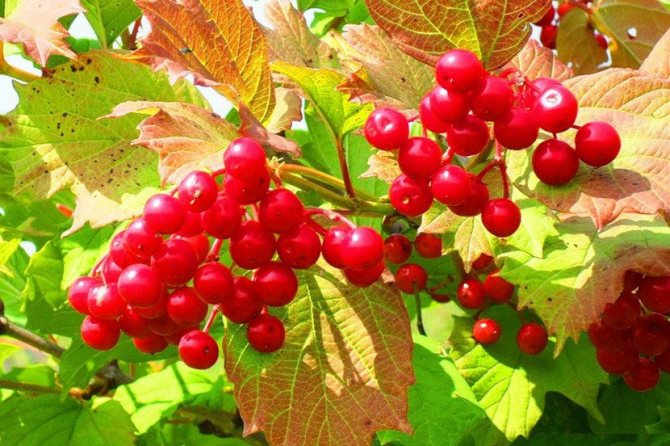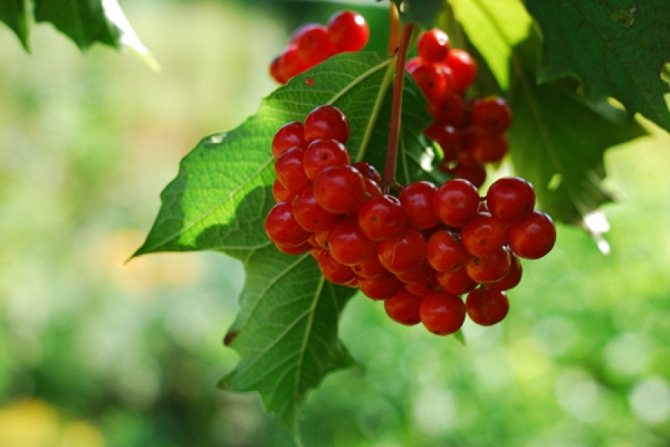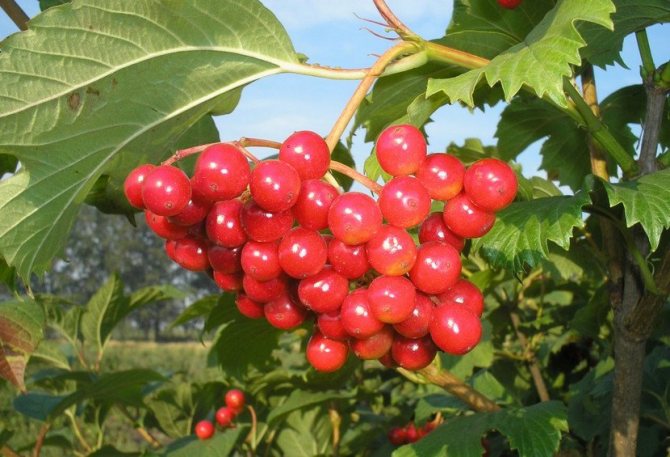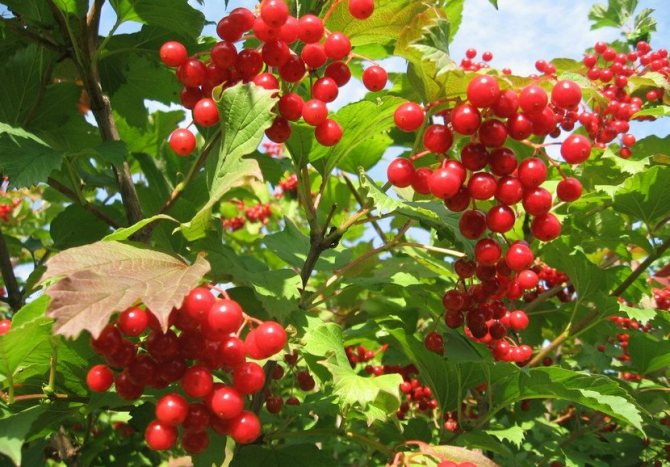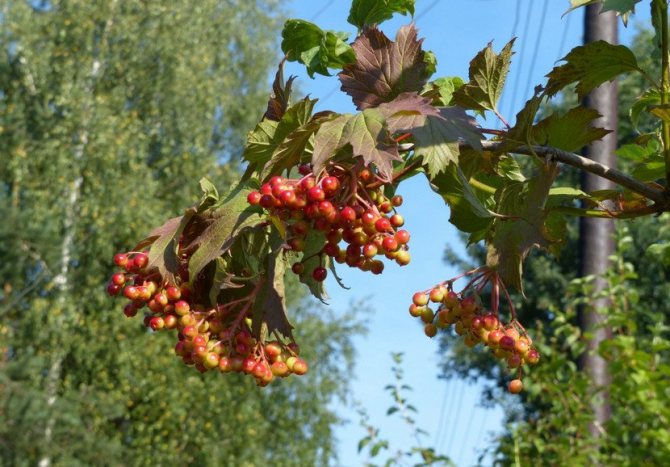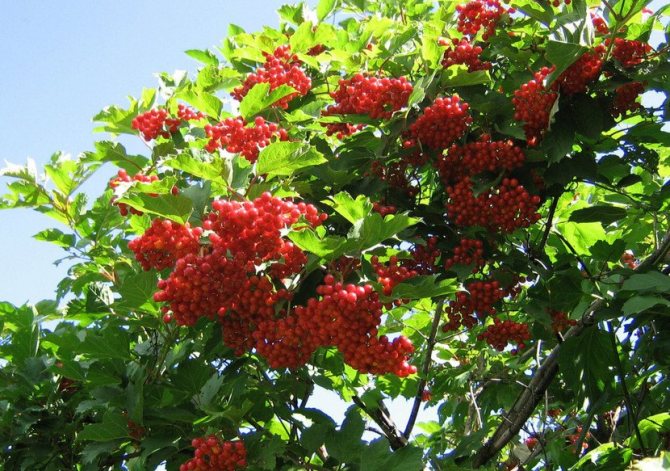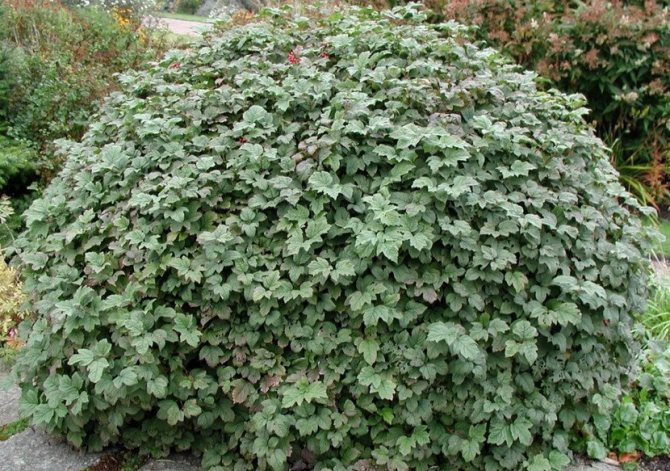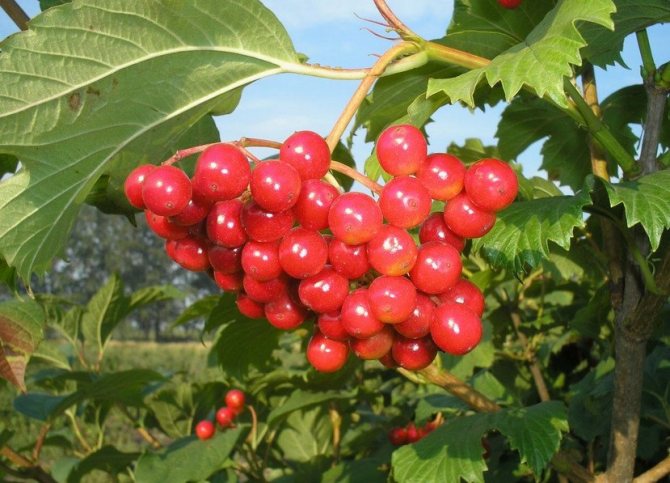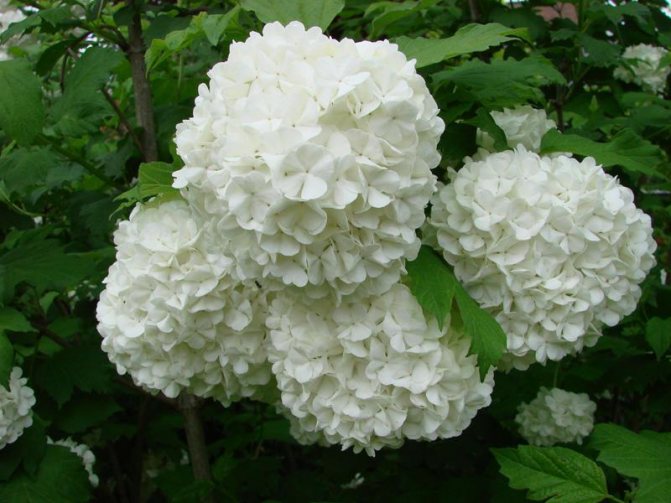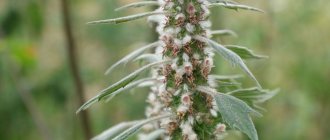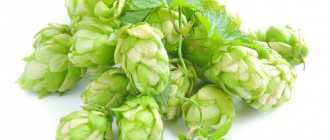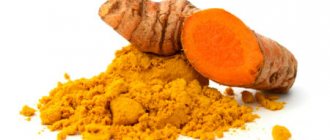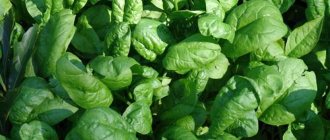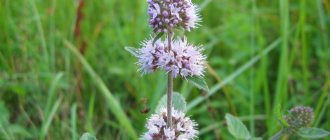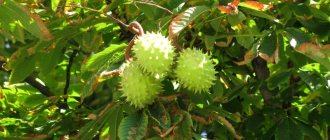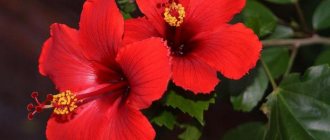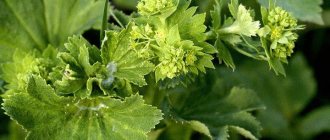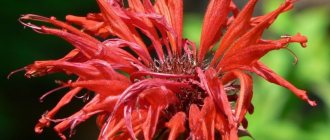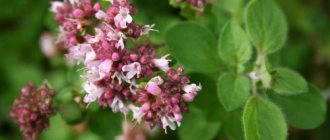From time immemorial, the beautiful viburnum has taken a firm place in Russian gardens. It's even hard to say when it looks more chic - during flowering, covered entirely with luxurious white caps of flowers, or in August-September - sprinkled with blood-red bunches of ripe berries.
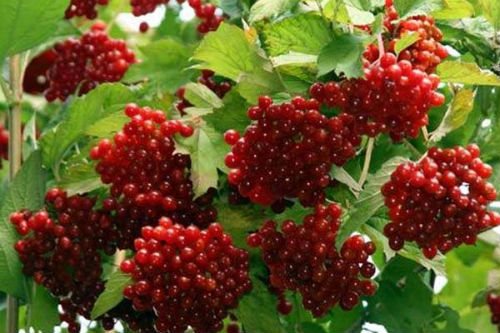
A wonderful shrub or small tree is sung in poetry and songs along with other primordially Russian plants, birch and mountain ash, of course, for its unique beauty, but it is impossible to deny the benefits that this culture brings to man. It is used for medicinal and culinary purposes.
Surprisingly, breeders have come to grips with such an ancient plant relatively recently - at the end of the last century. Perhaps this is due to the fact that viburnum grows everywhere, not paying special attention to climatic conditions. Nevertheless, in recent years, experts have carried out a graduation in the cultivation of certain varieties in different regions of the country.
Kalina avabuki
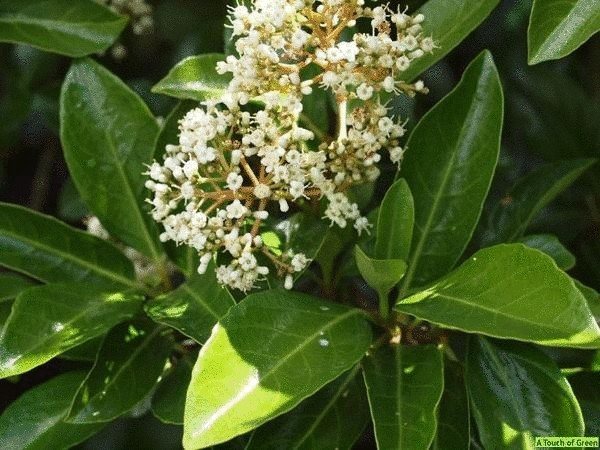

Japanese evergreen "stately" beauty - Viburnum awabuki, originally from Japan and South Korea. She is tall, up to 4 m and long-lived. The leaves are large, shiny. The flowers are white, collected in loose, drooping inflorescences; bloom in May-June. Bears fruit regularly in September, but produces few viable seeds.
Growing features
Relatively winter hardy species. On the Black Sea coast of the Krasnodar Territory, in severe winters with an absolute minimum of -10-11 ° C, only leaves are damaged to a greater or lesser extent. On the southern coast of Crimea, in cold winters, the ends of annual shoots freeze slightly with the loss of most of the leaves. It tolerates partial shade, but needs a sunny location and moderately moist, fertile, clayey soils for abundant flowering. It is resistant to pests. Propagated by cuttings. Good plant for exotic groups, hedges.
Breeding specifics
Even if viburnum varieties do not require special care, some features should still be taken into account.
Garden viburnum, like most types of shrubs, is planted in open soil on the site in spring, after warming up the earth, or in the fall, before the onset of cold weather.
Viburnum fruit Taiga Ruby
Edible viburnum leaves hatch relatively late. Seedlings with open roots are preferably planted in April and May days, they will have time to start before the buds swell. In addition, they will feed on moisture remaining in the ground from melting snow.
Note! A tree with a closed root system (in a container or a sturdy bag) has no time limit for planting.
Description of the benefits of closed roots:
- Works can be carried out in spring, summer and autumn - from September to November.
- When planting in the chosen place, there is no possibility of damage to the root system, since it is protected from the outside.
- Such seedlings, when properly planted, have a shortened acclimatization period and a high survival rate.
Suitable soil, watering and fertilizing
Shrubs can take root in any soil, which is why wild viburnum is so common. But it is desirable that the substrate is light, fertile.
Despite the fact that viburnum loves moisture, water stagnation is contraindicated for it, therefore, when planting, drainage must be done in the hole. It is worth choosing a sunny place, but in a small shade the bush will develop rapidly.
Advice! Watering is best done in the evening. You need up to 40 liters of water per square meter. This is especially true for the period of flowering, fruiting and drought.
Fertilize 4 times from spring to winter. For the first time - when throwing out foliage, the second and third times - before and during flowering, the last - before wintering.
Pruning
Without pruning, the number of shoots will increase rapidly, they will all tend upward towards the sun, and soon the shrub will turn into an unkempt clump of tangled branches.
Pruning is a very important part of crop maintenance. Depending on the need, perform:
- sanitary;
- thinning out;
- formative trim.
In the first method, diseased, dried, frozen shoots are removed, in the second case, they get rid of excess, densely growing and irregular branches that interfere with the development of the plant. The last type of pruning is carried out in order to give the culture an aesthetic appearance by forming a crown.
Sanitary pruning is carried out at any time of the year, thinning - from mid-spring and during the summer, shaping - in early spring, 2-3 times in summer, in late autumn.
Pests
Periodically, viburnum can be overcome by pests that adversely affect the plant and negatively affect the quality and quantity of the crop.
The tree is attacked:
When fighting these insects, you need to shake them off the shoots every morning on a film spread under the crown. Then get rid of them.
Purchased complex action products cope with unwanted "guests" perfectly: fufanon, lightning, kinmix, karbofos, fitoverm, green soap.
Diseases
Viburnum viburnum is susceptible to the following diseases: powdery mildew, gray and fruit rot, yellowing, mosaicism and leaf spot can also be observed.
Note! Struggling with an ailment, you need to find out the cause of its appearance, purchasing drugs for treatment, focus on a specific type of disease.
Kalina Barkwood
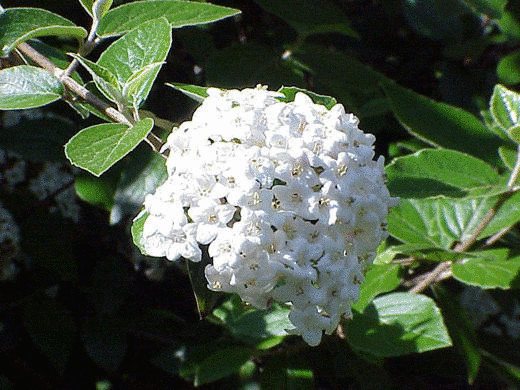

The snow-white beauty (during the flowering period) - Barkwood's viburnum (Viburnum x burkwoodii) is a garden hybrid of Karls' viburnum and useful viburnum. It is a semi-evergreen shrub 2.5 m high and wide. Leaves are longitudinally wrinkled, up to 10 cm long. The flowers are pinkish-white, fragrant, in large umbellate inflorescences, up to 9 cm in diameter. Blossoms in spring; fruits are rarely formed. There are decorative forms.
Growing features
Propagated by cuttings. Prefers light shade and well-drained, fertile soil. A good plant for small groups and close-range tapeworms.
Fertilization and watering
In dry times, the plant needs watering (twice a week, 2 buckets of water under the bush). To get a good harvest of berries and lush color in decorative forms, it is recommended to feed the viburnum:
- in the spring it is recommended to carry out 2 dressings. Before the buds swell, urea is scattered in the near-stem circle (50 g per 1 m2). Before flowering, you can use potassium sulfide (50 g per 1 m2) or wood ash (1 tbsp. Scatter and lightly dig around the bush);
- in the second half of summer, viburnum needs phosphorus and potassium, so you can apply complex mineral fertilizers (75 g) or 50 g of phosphorus and 25 g of potassium fertilizers per 1 m2;
- every 2 years, when digging up the soil around the viburnum, rotted manure is introduced into the trunk circle (a bucket under the bush).
Important! After sprinkling mineral fertilizers, the bush must be watered. If the weather is dry during summer feeding, it is recommended to dissolve the fertilizers in water.
Kalina bodnantskaya
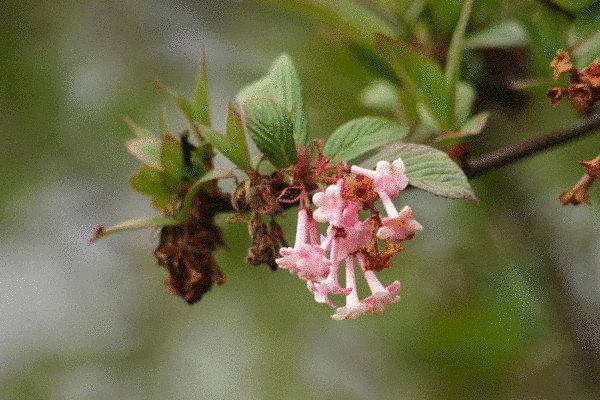

A very difficult to pronounce form is the bodnant viburnum (Viburnum x bodnantense), which, like the previous one, is a garden hybrid, but fragrant viburnum and large-flowered viburnum. It is a deciduous shrub up to 3 m high, grows in breadth up to 2 m. Leaves up to 10 cm long, young bronze. The flowers are light pink, collected in apical plates, up to 7 cm in diameter.Fruits are rarely set. There are decorative forms, the most interesting among them is ‘Dawn’ (flowers are dark pink, collected in convex corymbose inflorescences, white when flowering).
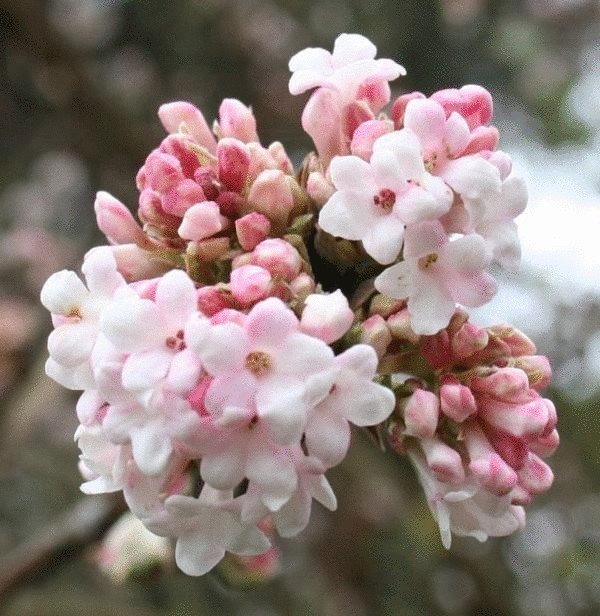

Growing features
Propagated by cuttings. Grows well in full sun and partial shade; prefers fertile, loose soil. Good in small groups in the foreground.
Viburnum care
Viburnum care in spring


In the last days of March or the first days of April, the site should be cleaned from the foliage that fell last year. The surface of the trunk circle must be loosened. After a little time, it is necessary to carry out preventive treatment of viburnum with fungicides, which can destroy all pests and pathogenic microorganisms that have settled down for wintering in the bark of trunks and branches, as well as in the upper layer of the soil. For processing, you can use a urea solution (7%), it will not only destroy pathogens and pests, but also become a source of nitrogen, which is so necessary for the Kalina in the spring. However, it should be borne in mind that it is impossible to spray the plant with urea if its buds have begun to open, otherwise they may burn out.
Around the middle of May, the bushes are fed with potash fertilizers. When the viburnum finishes blooming, complex fertilizer will need to be applied to the soil of the trunk circle.
Viburnum care in summer


Carry out a systematic examination of the bushes for the presence of pests or signs of disease, if necessary, carry out appropriate treatment. In the first days of summer, it is recommended to process the viburnum with tobacco infusion, or from June until the very harvest of the fruits, systematically spray the plants with an infusion prepared from onion husks, potato tops or garlic.
In addition, in the summer, the viburnum must be systematically watered, loosened the surface of the trunk circle and remove weeds.
Viburnum care in autumn
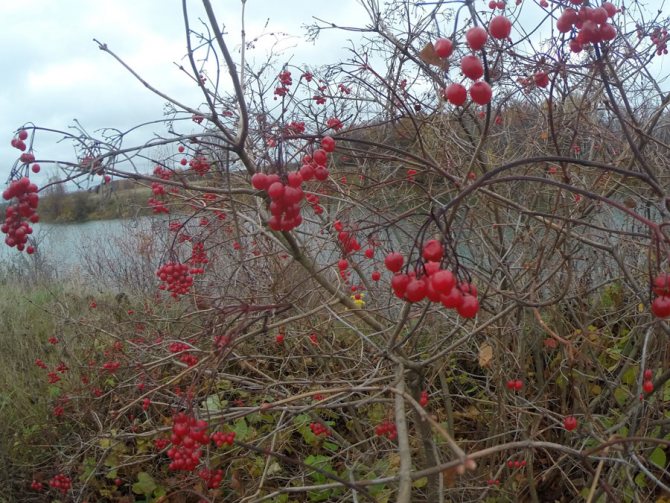

When all the leaves fall off the viburnum bush, they will need to be raked, like the old mulching layer. Then the plant is treated in order to prevent various pathogenic microorganisms and pests, which prefer to winter in the bark of a bush or in the upper layer of the soil. Further, the surface of the trunk circle is covered with a layer of mulch (rotted organic matter) or liquid fertilizing is applied to the soil.
After the frosts become resistant, it is necessary to collect the fruit clusters from the plants, after which they are removed for storage.
Viburnum processing
Viburnum, like many other garden crops, is susceptible to various diseases, and various pests can also harm it. To protect the plant, you will need to regularly spray it for prophylaxis, and this is done in spring and autumn. To get rid of pests, plants are treated with insecticides, fungicides are used to destroy fungal diseases. Bacterial and viral diseases are incurable. But you should know that various pests and their larvae are the main carriers of such diseases, therefore it is so important to process plants in a timely manner and not forget about preventive spraying.
Watering viburnum


Kalina needs regular watering, which is recommended once a week, especially if there is a sultry dry period. For 1 bush that bears fruit, it should take 30-40 liters of water for 1 watering. A young bush does not need so much water, but it should be watered as well once a week. If there is a lot of rain in the summer, the frequency of watering will certainly change, but remember that this plant is moisture-loving, so you should not take too long breaks between waterings.
Fertilizing viburnum
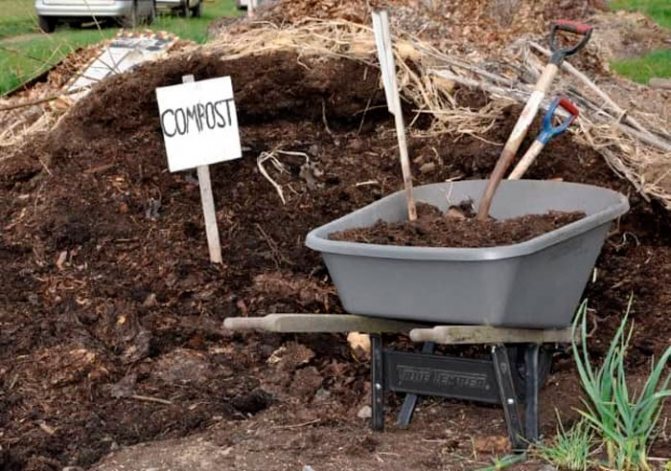

Since the plant needs frequent watering, it is recommended to feed it with dry fertilizers. They are simply evenly distributed on the surface of the trunk circle, and therefore the bush is watered.The first time you need to feed the plant is in the spring, during the opening of the foliage, for this, a couple of large spoons of urea are poured under each instance. But they produce such spring feeding only if the bushes have not been treated with urea through dormant buds.
The second time the viburnum is fed before it blooms, in this case, a fertilizer containing potassium is used. So, under each bush you need to pour a couple of large spoons of potassium sulfate or 500 ml of wood ash.
The third time such a plant is fed is when it fades. To do this, a couple of large spoons of Nitroammofoski are poured under each copy.
The fourth and last feeding of the plant is needed only when the surface of its near-stem circle is not covered with a layer of organic matter for the winter. For such feeding, a solution is taken, consisting of 1 bucket of water, in which two large tablespoons of superphosphate and potassium sulfate are dissolved. For 1 bush, 20 liters of such a nutrient mixture is taken.
Kalina gordovina
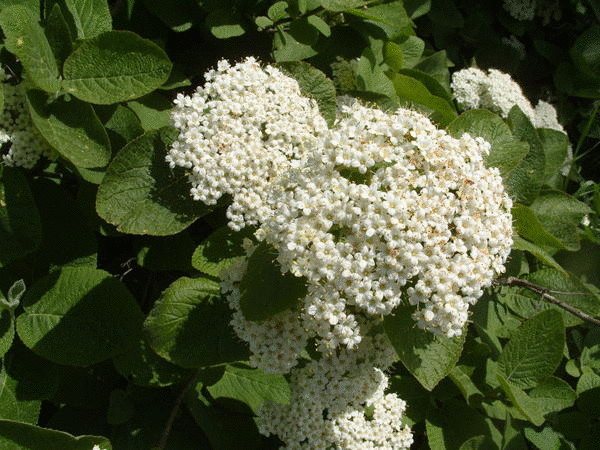

Many famous viburnum gordovina (Viburnum lantana). She is native to Europe, North Africa, Southwest Asia. It is a deciduous shrub 2-4 m high. The leaves are rounded-ovate, up to 12 cm long. The flowers are creamy white with a delicate pleasant aroma, collected in inflorescences - convex umbellate panicles, up to 10 cm in diameter; bloom in May. The fruits turn red at first, as they ripen, they acquire a blue-black color with a light bloom. They are larger than the fruits of other types of viburnum, reaching a length of 12-15 mm. They ripen in September-October and are pecked very quickly by birds.
Growing features
Viburnum of medium growth rate, shade-tolerant, frost-hardy, withstands frosts down to -23-25 ° C (at lower temperatures, leaves freeze over). It tolerates saline soils, is drought-resistant, but grows better with watering. It blooms profusely and bears fruit on fairly moist, fertile, regularly tilled soil. Known for its endurance in a wide variety of conditions. Can be used for single and group planting in open areas and in partial shade. It is slightly damaged by pests. Propagated by seeds, cuttings and layering. Seed germination lasts 2 years. Before sowing, it is recommended to stratify the seeds at 5-10 ° C for up to 3 months. There is information about possible thermal stratification at the same time. Seeding depth is up to 3 cm. One of the most ornamental shrubs with beautiful foliage, inflorescences and fruits, suitable for planting in summer cottages with tapeworms and groups.
Planting viburnum in open ground
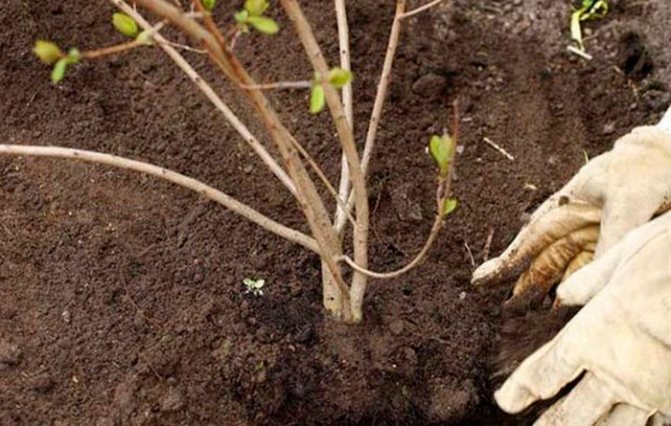

What time to plant
Planting and growing viburnum is a snap. For it, you should choose a neutral or slightly acidic (pH 5.5 to 6.5) soil. For planting it, you should not choose areas with podzolic, peaty or sandy soil. You also need to pay attention to groundwater, they must lie on the site at a depth of at least 100 centimeters. In order to extend the life of this plant and make it stronger and healthier, you should create conditions for it as close as possible to natural ones.
This crop can be grown in a well-consecrated area, but partial shade is better for this. According to some experts, pests settle on a bush growing in a shaded area much less often.
Viburnum seedlings are planted both in autumn and spring. Before the planting itself, the site is subjected to digging, and all weeds are removed from it. If the soil on the site is nutritious, then the introduction of organic fertilizers into it will be superfluous. If the site is with poor soil, then fertilizers are applied directly to the planting pit during planting of the seedling.
Planting viburnum in spring
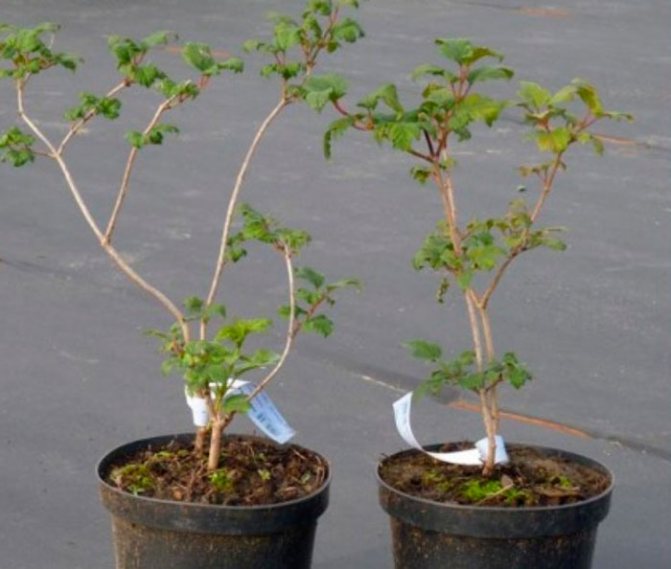

In spring, the viburnum should be planted before the leaf plates open. The size of the landing pit should be 0.5x0.5x0.5 meters.In the event that several bushes are planted, then a distance of 2.5 to 3.5 meters should be maintained between them. When preparing the pit, the topsoil must be folded back separately. It is combined with 1 bucket of peat or humus and with a couple of glasses of Nitrofoski. 2/3 of the resulting soil mixture must be poured into the planting pit, and 40 liters of water are poured into it. The pit will be ready for planting in a few days. After about 7 days, the remaining soil should be poured into the planting pit with a mound, while it should rise above the surface of the site by 10-12 centimeters. For planting, a three-year-old seedling is used. Its roots should be installed on the resulting mound. After the roots are straightened, the pit must be filled with the rest of the soil mixture. The trunk circle of the planted plant must be tamped well, then it is watered abundantly. When the water is absorbed, the surface of the trunk circle should be covered with a layer of mulch (peat, compost or humus). It is necessary that after planting the root collar of the viburnum is about 50-60 mm buried in the soil.
Planting viburnum in the fall
In the fall, the viburnum seedling is planted in open soil in the same way as in the spring. It is necessary to plant during the period of leaf fall, while you need to be in time before the first frost.
Kalina David
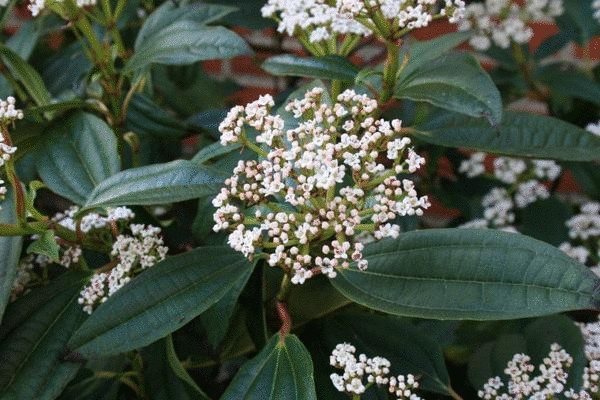

Chinese evergreen beauty - David's viburnum (Viburnum davidii); homeland: Western China. It is a compact, squat shrub, 1-1.5 m high and wide. The leaves are like those of a plantain, up to 15 cm long. The flowers are white, in rare, corymbose inflorescences; bloom in late spring. Rarely bears fruit.
Growing features
Propagated by cuttings. Prefers shady places with moderately moist and fertile soil. An original plant for shady gardens.
TOP popular varieties
One of the advantages is a huge list of different types of viburnum. Both deciduous and evergreen shrubs or trees are cultivated. Farmers grow both remontant and non-fruiting varieties of this plant, which differ in a variety of shapes and sizes. There are even subspecies blooming in winter - these are Forreri and Bodnantenskaya viburnum.
The most popular are the following varieties of red viburnum:
- From medium-sized: Zholobovskaya, viburnum Red coral, Red bunch, Leningradskaya elite.
- From the vigorous ones: Roseum, Maria, Ulgen, Shukshinskaya, Dachnaya.
- From undersized: Eskimo, viburnum ordinary Nanum and viburnum Compactum, as well as Nana dwarf.
In regions with severe weather, the viburnum of the Shukshinskaya variety, as well as Zarnitsa, Zakat, Maria, Ryabinushka, Vigorovskaya, will best take root.
For areas with a temperate climate (for example, the Moscow region), Souzga, Ulgen, Zholobovskaya, the variety of viburnum Taiga rubies are suitable.
Gardens in warm areas will be decorated with Aurora, Elixir, Garnet Bracelet, Red Bunch.
A separate place is occupied by sweet-fruited varieties of viburnum, which are distinguished by the sweetish taste of berries without bitterness: Vigoroskaya, Souzga, Shukshinskaya, Bureinskaya, Leningradskaya Otbornaya.
Viburnum fragrant
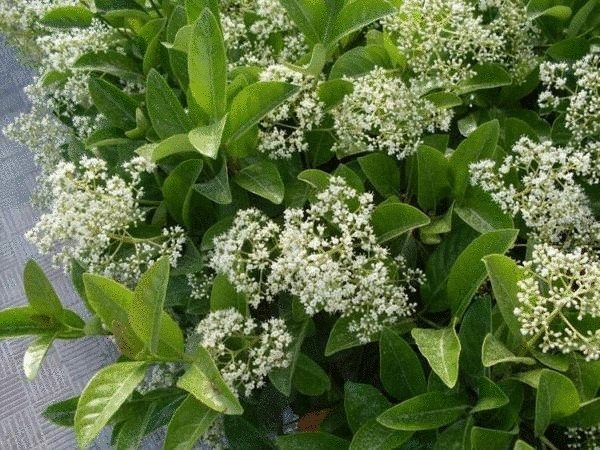

And again, the eastern viburnum - the fragrant viburnum (Viburnum odoratissimum) comes from the Southeast Himalayas, Central China. It is a large evergreen shrub, up to 5 m high and wide. The leaves are thick, glossy, elongated-oval, up to 20 cm long. The flowers are white, fragrant, collected in rounded clusters, 8-10 cm long. Red fruits are rarely formed.
Growing features
Low winter resistance: withstands a drop in temperature to -5 degrees C. Propagated by cuttings. Prefers shaded locations with moist, fertile, clayey, acidic soils. A beautiful plant for small groups and as a specimen under the crowns of tall trees.
Viburnum red application


In medicine, the fruits and bark of red viburnum are used. The fruits of the red viburnum are used in medical practice as a calming agent for the heartbeat, a tonic, vitamin and mild diuretic.They are included in the vitamin collection. The fruits collected after frost are used to treat the initial stage of hypertension and cough. The extract and decoction of red viburnum bark is used for internal bleeding, as well as an antispasmodic and sedative in gynecology.
Viburnum juice is especially useful, it normalizes blood pressure, has a beneficial effect on stomach ulcers, coughs, liver and gall bladder diseases.
Viburnum fruits are widely used in home cooking. Fruits are canned, juices and jelly, preserves, jellies, marmalades, pie filling, fruit drinks are prepared.
Kalina Karlsa
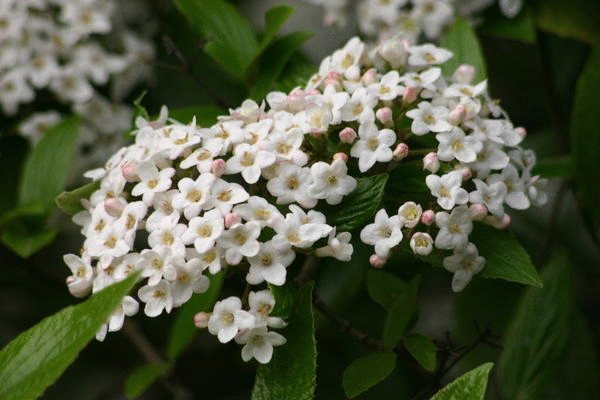

Eastern beauty - Carls' viburnum (Viburnum carlesii); homeland: Korea, Japan. A small deciduous shrub up to 2 m high and wide. The leaves are ovoid-oval, wrinkled. The flowers are white, as if sculpted from wax, collected in rare corymbose inflorescences, with a very delicate scent; bloom before the leaves bloom, in April-May. Fruits are rare. There are decorative forms, the most decorative is 'Aurora' (the bush is more compact, the flowers are pale pink). The fruits are blue-black drupes, ripening in September-October.


Growing features
In eastern Europe, where Karls' viburnum is widely used in landscape design, it tolerates frosts down to -30 ° C. Prized for its fragrant pink flowers in early spring, orange-red leaves and blue-black fruits in autumn. Good in solitary and group plantings. It is not demanding on lighting conditions, but the most lush flowering is observed in partial shade, on fertile, drained soils. It propagates well by grafting on the Hordovina, seeds and cuttings. Sowing in autumn after harvest or in spring with stratification. Without it, the emergence of seedlings is delayed up to 2 years. It is resistant to pests.
Correct pruning of viburnum
Viburnum is a fast growing plant. During the year, its branches grow by 50 cm, so the bush must be cut off annually. It is recommended to do this in early spring before the start of sap flow, taking into account the following rules:
- be sure to remove dry, damaged, old (over 6 years old) branches;
- part of the branches in the center of the crown should be removed to ensure good illumination, on which the yield of viburnum depends.
Pruning helps the plant not only develop well and bear fruit, but also allows you to adjust the size and volume of the bush.
With the correct pruning, you can form a small tree from a viburnum bush. In this case, the formation is carried out around the selected central trunk, and all side branches and root shoots are removed. When an even trunk with a height of about 2 m is formed, they begin to form the crown. To do this, pinch the central trunk so that it begins to branch.
You also need to know some of the features of pruning different varieties of viburnum. For example, if you grow Buldenezh viburnum, then for the future abundant flowering of the seedling in the first year, it is necessary to cut off the inflorescences that have appeared. This will give the plant an opportunity to direct its forces towards rooting and strengthening. In subsequent years, pruning of the bush is recommended in the fall, so that the plant has time to lay new flower buds for lush flowering next year.
Viburnum cinnamon-leaved
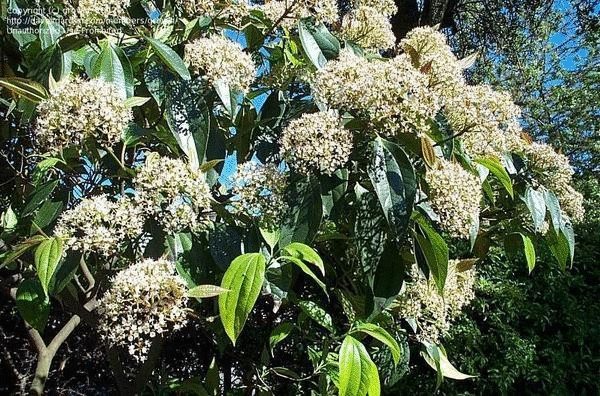

Another Chinese viburnum is cinnamon-leaved viburnum (Viburnum cinnamomifolium), homeland: Western China. This is an evergreen shrub with a loose and at the same time columnar crown. The leaves are not typical for viburnum, they are more like cinnamon leaves: oval-pointed, bent along the central vein, serrate, with arcuate veins, shiny, brownish-green in color. The flowers are inconspicuous, the fruits are rarely formed.
Growing features
Not hardy: withstands a drop in temperature to -5 degrees C. Propagated by cuttings. It is undemanding to light conditions, needs acidic soils. A kind of plant for complex groups.
Varieties for gardeners
Gone are the days when "just viburnum" grew on the site.Thanks to the work of scientists, it became possible to acquire and grow special varieties that meet the requirements of gardeners. Some focus on the decorativeness of the plant, they do not care about the number of berries in the fall, while others, on the contrary, it is important to get a harvest in order to start harvesting fruits for the winter.
In folk medicine, viburnum is used as a fortifying agent, which is facilitated by the high content of vitamin C, as well as to relieve fever. In addition, the diuretic and laxative effects of eating berries have been noted. Fruit juice lowers blood pressure. In reasonable portions, it improves digestion.
Viburnum large-headed
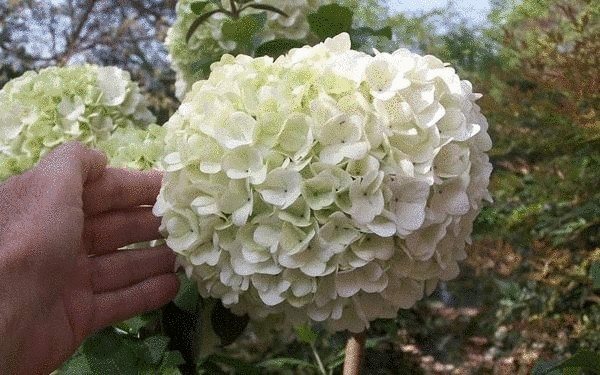

Viburnum macrocephalum, very effective during the flowering period, is a semi-evergreen or deciduous shrub up to 5 m high and wide. This is a garden hybrid. Leaves are ovate-oval, up to 10 cm long. The flowers are white, sterile (do not set fruits), collected in large, spherical inflorescences, up to 15 cm in diameter! The inflorescences are similar to the inflorescences of the Viburnum vulgaris 'Pink'; the same greenish at the beginning of flowering and turning pink when flowering.
Growing features
Low winter resistance: withstands a drop in temperature to -5 degrees C. Propagated by cuttings, but poorly. Prefers light shade and moist, fertile, acidic soils. Spectacular plant as tapeworms and for small groups.
Viburnum pests with photos and descriptions
Kalina can harm a fairly large number of different pests. Those of them that pose the greatest danger to such a culture will be described below.
Viburnum leaf beetle


The viburnum leaf beetle is a small (about 0.6 cm long) beetle of pale brown color. Its larvae emerge from the soil in the first days of May. They eat the leaf plates of the plant, while only the veins remain of them. In the event that there are a lot of larvae, then they may not have enough foliage for all, then they begin to eat young shoots. Also, these larvae damage the viburnum berries. The females of such an insect gnaw grooves in the upper part of the shoot, in which they lay eggs. Because of such pests, the gardener can lose crops, and it also causes the plant itself to reduce its resistance to frost. Examine the tops of the shoots and cut off those where the egg has been laid. Then the viburnum must be sprayed with Fufanon or Karbofos.
Black leaf aphid
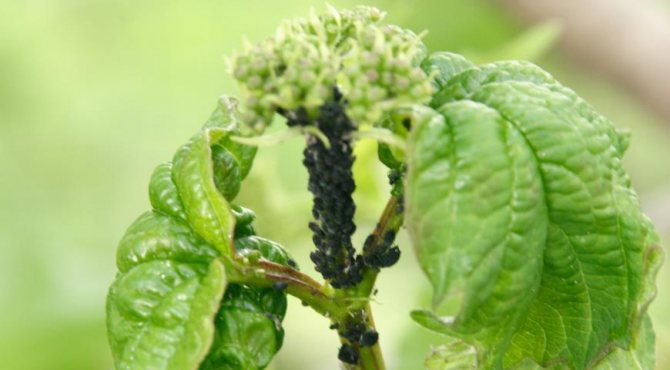

The black leaf-rolling aphid, like in principle any aphid, is the main carrier of diseases that cannot be cured. In this regard, when such an insect is found, all necessary measures should be taken to destroy it. Aphids feed on the sap of the plant, sucking it out of the leaf plates, as a result of which they curl up. The foliage changes its color to brown, it deforms and dries up, and the development of shoots stops. The ends of the shoots on which there is a colony of aphids should be cut off and destroyed. Spray the bush with Karbofos or Fufanon.
Viburnum leaf roll


Viburnum leafworm is a caterpillar of olive or dark-gray color. They first eat the buds, after which they entangle the leaves with cobwebs, crumple them and eat them. If there is a lot of such a pest on the bush, then this will have an extremely negative effect on the harvest. Track nests should be found and destroyed. Before the buds open, you need to spray the affected bush with a solution of Nitrafen (250 grams of paste for 1 bucket of water). The second treatment should be carried out between the beginning of the opening of the buds and the formation of buds, for this use a solution of Karbofos (10%).
Viburnum and honeysuckle gall midges
The larvae of these insects settle for the winter in the upper layer of the soil. The appearance of adults is observed during the formation of buds, in which they arrange egg-laying. The larvae eat the buds, making them bloated, red and ugly.Damaged buds do not open. At the beginning of the spring period or in late autumn, it is necessary to thoroughly loosen the surface of the trunk circle. Before the viburnum blooms, it must be sprayed with a solution of Karbofos (10%).
Green lobed moth


The green lobed moth is capable of harming viburnum, lilac and buckthorn. This pest is a greenish-yellow caterpillar that damages flower ovaries. They get rid of it in the same way as the gall midges.
Viburnum laurel, or evergreen
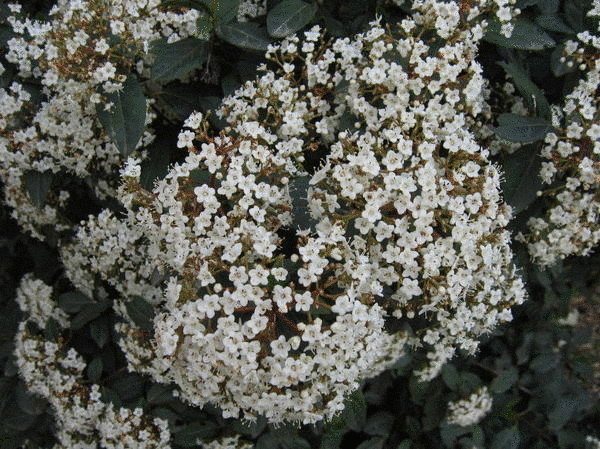

Mediterranean beauty - laurel viburnum (Viburnum tinus), which blooms on the Black Sea coast of Krasnodar Territory and the southern coast of Crimea, starting in winter, in early spring. It is interesting that the ancient Romans called many plants with the Latin word tinus, the leaves of which looked like the leaves of the noble laurel. It is an evergreen shrub, 1-3 m high. Leaves are leathery, sparsely and rigidly pubescent, pointed-oval. Flowers are white, sometimes with a pinkish tinge, collected in flat, corymbose inflorescences, 5-10 cm in diameter, which appear on normally developed plants almost all year round, but the most abundant flowering is observed in winter. Viburnum laurel is one of the most widespread and most resistant winter flowers not only in the Sochi region, but also in Yalta. Fruits are oval-pointed, pearlescent blue are always tied in abundance, and in summer this species is a spectacular, beautifully fruiting shrub. There are decorative forms.
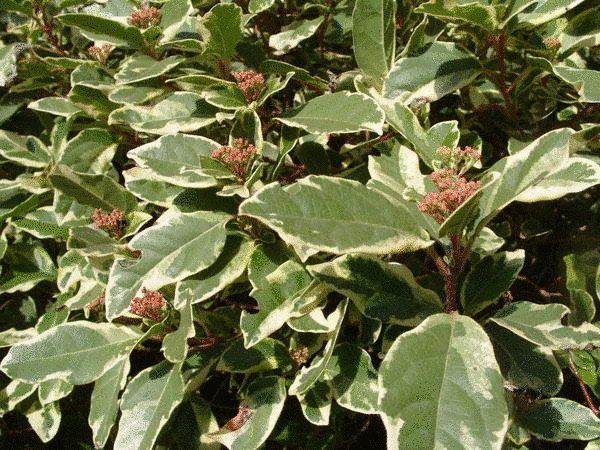

Growing features
At a temperature of -15 ° C, it freezes strongly. Drought tolerates well. Propagated by seeds (autumn sowing) or in spring by stratified seeds, as well as green cuttings (under glass) and layering. It develops well with light shading, on fertile, loose, neutral soils. Withstands pruning well, it is perfectly shaped and is used in topiary art. Can be used for solitary and group plantings, curbs and low hedges. In some years, it is severely damaged by viburnum whitefly, seaside mealy and viburnum bugs.
Disease and pest control
Fungal and bacterial diseases rarely affect viburnum, but they can lead to such troubles as loss of decorativeness, drying out of inflorescences and decay of fruits. It is important to identify and take measures to treat the plant in time.
Table: viburnum diseases
| Disease | Signs | Control measures |
| Frosty burn | Cracking and drying of the bark, dying off of exposed tissues. Mass appearance of pale leaves, gradually turning brown and drying out. |
|
| Ascochitous spot | Grayish rounded spots with brownish edging on foliage. In these spots, the causative agent of the disease, the fungus, multiplies. Over time, the spots crack, dry out, and the middle falls out. |
|
| Gray rot | The foliage is covered with a brown bloom. The same plaque appears on berries. On top of the brown color, a grayish-smoky plaque of mycelium can appear. |
|
| Fruit rot | Drying of young shoots, flowers, leaves and berries. The fruits are first covered with small scales, then turn black and dry. |
|
Photo gallery: signs of viburnum diseases
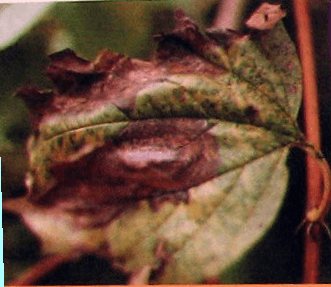

With a frosty burn, pale, chlorous, quickly drying leaves appear on the affected shoots of the viburnum
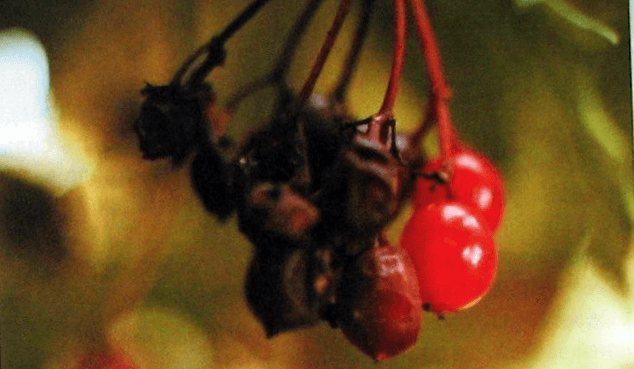

The berries affected by gray rot turn brown and dry, the mycelium penetrates them through and through.When affected by ascochitous spotting, rounded or angular gray spots with a dark brown border appear on the leaves of the viburnum
Harmful insects quite often attack viburnum and pose a serious danger to it. The plant loses its decorative effect, flowers and crops may die completely. Timely treatment of the bushes with appropriate compounds will protect the plant from insects.
Table: pests of viburnum
| Pests | Signs of defeat | Control measures |
| Viburnum aphid | Twisted, deformed, dried leaves. | Treatment with Intavir, Karbofos (according to the instructions). |
| Viburnum leaf beetle | The appearance of large holes in the leaves. A large pest colony attacks fruits and branches. |
|
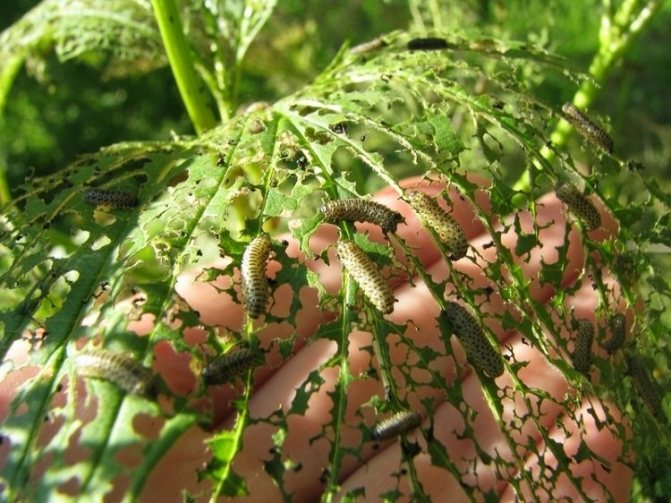

During the years of mass reproduction, the viburnum leaf beetle can gnaw the entire bush so that there will be no greenery left at all
Viburnum wrinkled
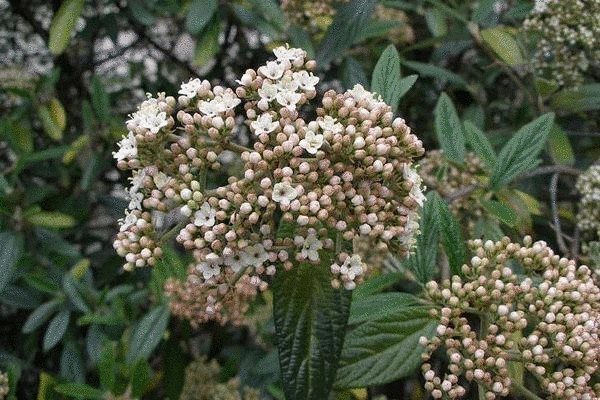

Another Chinese evergreen beauty is wrinkled viburnum (Viburnum rhytidophyllum), homeland: Central and Western China. This is a tall shrub (3-5 m), grows in breadth up to 4 m, with a rather loose, sparse crown. The leaves are large, up to 20 cm long, hanging, with an interesting relief-wrinkled structure. The flowers are small, creamy white, collected in loose, flattened inflorescences, up to 20 cm in diameter; they are decorative and in the bud stage; bloom in April-May. Fruits are blackish-purple and set well.
Growing features
Requires moderately moist soils or normal watering during growth, semi-shade, sheltered from dry winds, location, neutral soils. It is the most hardy of all evergreen viburnum. Easily propagated by seeds and vegetatively (cuttings). Effective in single and group plantings. It is slightly damaged by pests.
The most decorative varieties with names and photos
Flowers and ornamental shrubs are conquering more and more space from summer cottages. Kalina will find a place for itself on any site. Adult shrubs grow up to 1.5-6 meters in height, from which they form a bole or do bush decorative pruning. Viburnum is good in group planting, as a green hedge and as a single ornamental plant.
Viburnum ordinary
Viburnum vulgaris blooms with corymbose fragrant inflorescences up to 15 cm in diameter. Greenish flowers turn into a boiling white color as they bloom. The plant tolerates drought and frost well.
"Buldenezh"
Variety "Buldenezh" blooms with sterile white spherical inflorescences. Abundant flowering begins in early June and lasts about three weeks. This variety does not produce berries, but it colors the autumn garden with yellow and burgundy foliage.
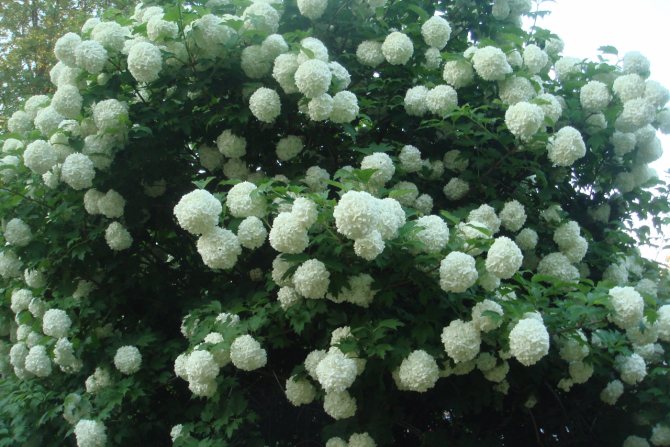

Kalina "Buldenezh", as a rule, is formed in gardens in the form of a small separate tree-bush no more than 2.5-3 meters high
"Roseum"
Roseum is another decorative variety that does not produce berries. The height of an adult bush is up to 3 meters, the volume of the crown is 4 meters. It blooms like "Buldenezh" with white globular inflorescences from the end of May to the 20th of June. In the fall, the foliage turns purple. Roseum is used in group plantings.
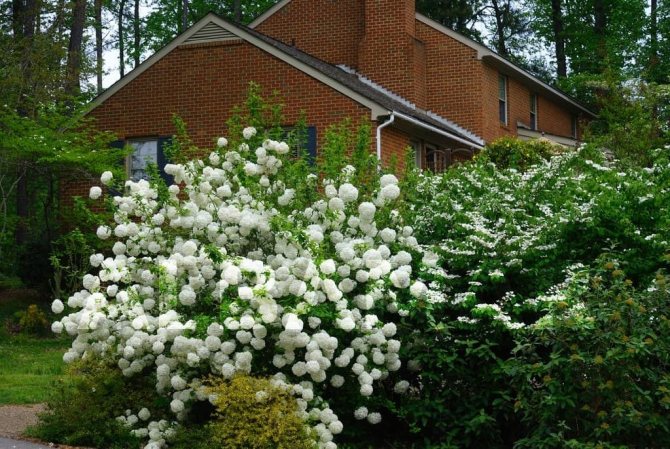

Roseum is excellent for the formation of hedges due to the high density of the crown
"Compactum"
The "Compactum" variety is suitable for a small garden. The height and volume of the crown is 2 meters. The rounded crown is compact (hence the name). Abundant umbellate snow-white inflorescences bloom in May and bloom for almost a month. "Compactum" is a cultivar grown in a trunk.


In the shrub form, "Compactum" is used to create a hedge, in the standard form - as a single decoration of the garden
Dwarf "Nanum"
The dwarf viburnum "Nanum" is a real find for landscape design. The hemispherical shape of the crown, carved leaves and a height of only about a meter make the bush indispensable in the composition of borders, rockeries and herbaceous compositions.
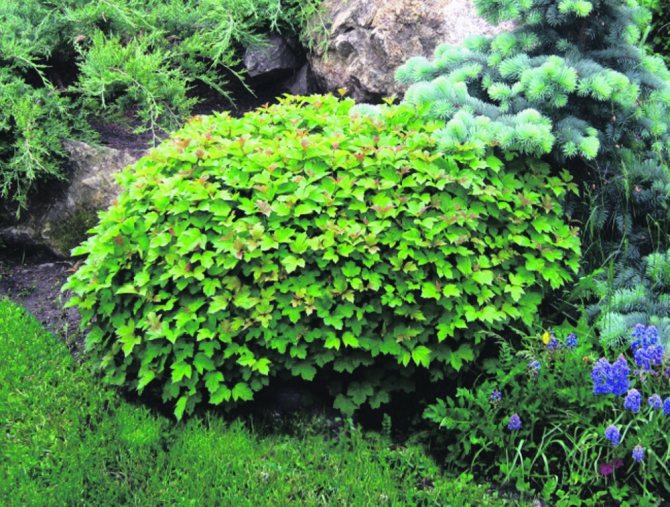

"Nanum" blooms very rarely with single inflorescences
"Xanthocarpum"
Variety "Xanthokarpum" is a small (up to 2 m) shrub, blooming with large inflorescences characteristic of the common viburnum. Its large carved dark green leaves are good. But it becomes especially beautiful by autumn, when clusters of large creamy yellow berries appear on it.
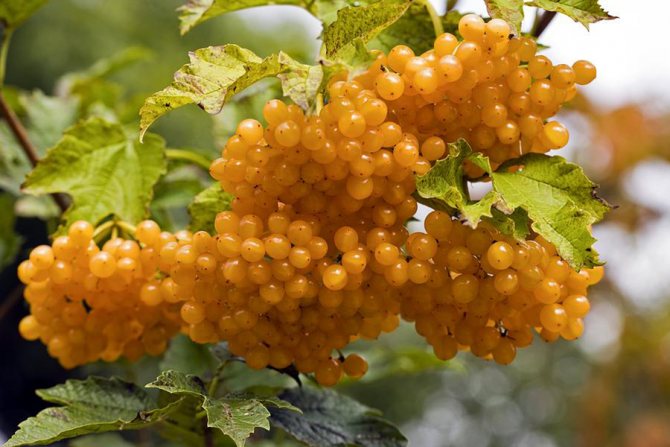

"Xanthocarpum" looks good in compositions with other shrubs and trees, decorates the banks of rivers and reservoirs, is used in park plantings
Viburnum folded
Folded viburnum is an Asian species of viburnum, a shrub that reaches three meters in adulthood and has a stepped crown shape. Slowly growing in the first years of life, later it grows, stretching out in breadth densely leafy branches. There are two forms of folded viburnum. One is long-flowering with globular inflorescences and purple-brown autumn leaves. The second is tall with flat white or pale pink inflorescences. Viburnum folded as an ornamental plant is not very common in Russia, it is more loved in Europe. But she has good prospects, since this species is frost-resistant and suitable for breeding in central Russia.
"Watanabe"
The Watanabe variety adorns the garden throughout the season. Delicate flat inflorescences bloom in July and bloom until the end of August. In October, the bush blooms again.
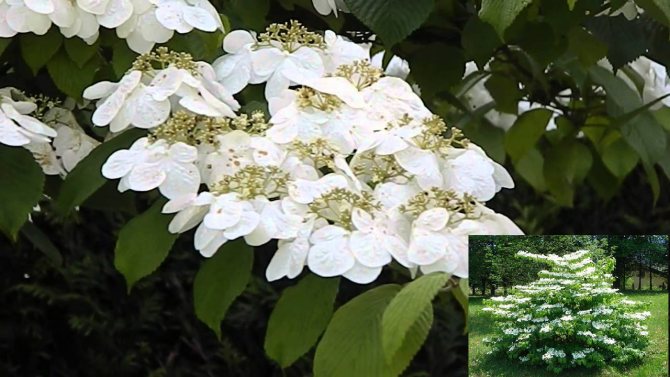

Flowering ends with the formation of bright red oval berries, gradually acquiring a bluish-black color
"Cascade"
Variety "Cascade" is a compact bush 1.5-2 meters high with flat white inflorescences up to 10 cm in diameter. They look great against the background of dark green foliage, which becomes dark red by autumn. Its branches cascade down from the top to the ground, for which the variety got its name. Inflorescences are replaced by heavy large clusters of bright scarlet berries. The flowering period is May – June.
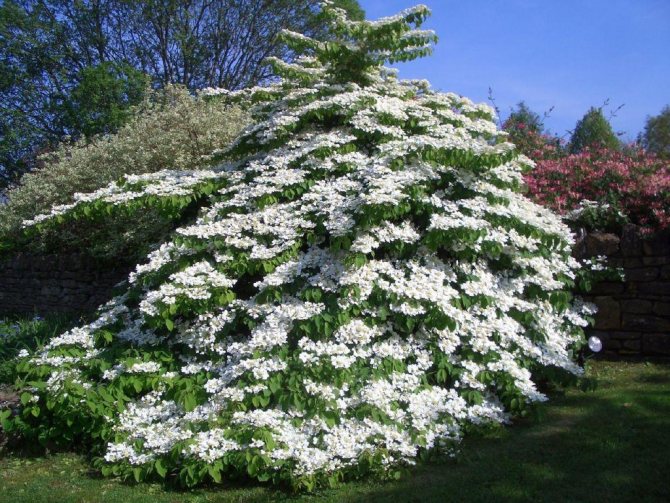

"Cascade" looks better in single landings
"Pink Beauty"
“Pink Beauty is a low shrub with an extensive (up to 2.5 meters) crown. Its flowers are creamy at first, with time turning pale pink. The glossy dark green leaves are similar to laurel. The berries, as they ripen, turn from bright pink to bright blue until they acquire a blue-black color. Very good variety "Pink Beauty" in the fall. On one bush, the leaves against the background of the remaining dark greens are painted in burgundy, bronze, crimson and dark purple.
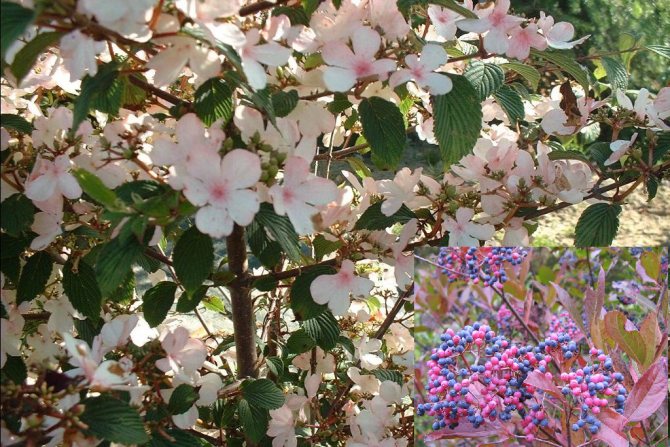

Variety "Pink Beauty" - one of the most spectacular decorative varieties of viburnum
Kilimanjaro Sunrise
"Kilimanjaro Sunrise" is a new variety, but it already managed to become "Plant of the Year" in 2015 in a prestigious British competition. It is a neat shrub in the shape of a pyramid, blooming with white flowers with a pink border, collected in numerous flat inflorescences. When flowering begins (and this is early spring), the greenery is completely hidden under the cover of delicate flowers. Then red berries appear on the brushes, which turn black by autumn.
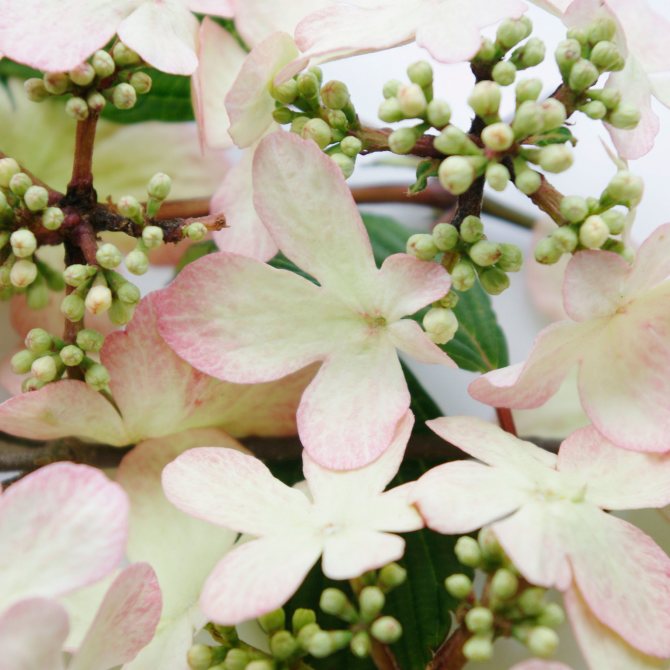

The leaves of "Kilimanjaro Sunrise" are painted in bright red and yellow tones during the leaf fall
"Mariesi"
Variety "Mariesi" is a shrub 2.5-3 meters high with large white inflorescences. Loves sunny places, but does not tolerate extreme heat and drought. The plant is purely decorative, does not bear fruit. Autumn leaves are wine red or deep purple.
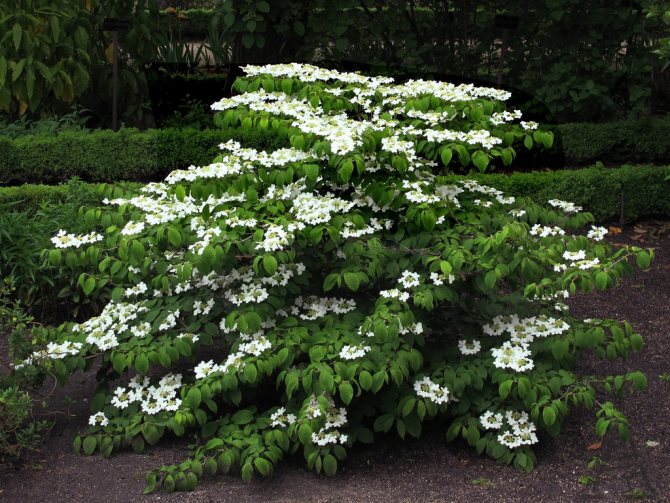

Variety "Mariesi" is distinguished by long flowering, tolerates frosts down to -20 ″ С
Kalina gordovina
Gordovina is called black viburnum for the color of oblong berries. It is a large shrub plant that grows up to 6 meters in height. Due to its large but compact crown (3-4 m), the gordovina looks like a tree. Slightly wrinkled oblong leaves are large, up to 18 cm. Due to the fact that the branches and leaves are covered with a silvery fluff, Viburnum Hordovina is called a fleecy shrub.
"Renaissance"
Gordovina "Renaissance" is a real find for a gardener. The bush grows up to 3 meters, grows quickly, the volume of the crown is 1.5–2 meters. The plant is not afraid of drought, frost, poor soil and pests.The "Renaissance" variety is decorative all season. It looks great in compositions or in the form of bushes chaotically scattered over the site.
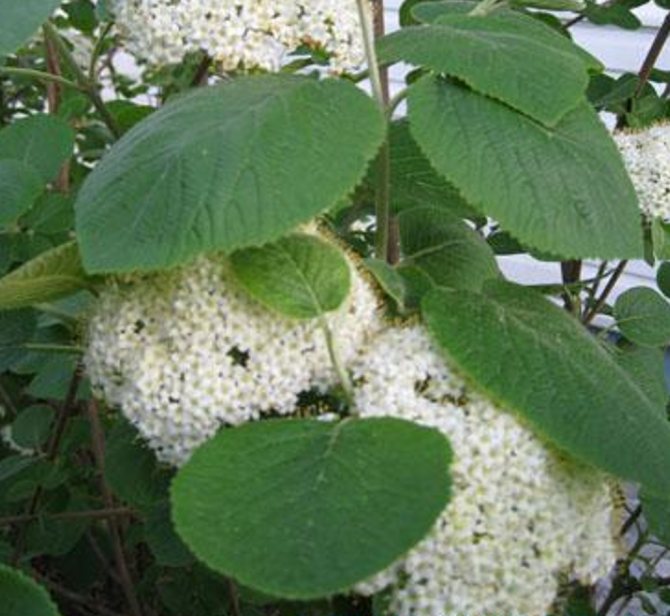

Wide dense leaves turn pink-red in autumn
"Aureum"
Gordovina "Aureum" is a short shrub with unusual golden-yellow foliage. It grows up to two meters in height. Flowering begins in May and ends in a month. Shield-shaped inflorescences are collected from small white-cream flowers. The shrub grows slowly, adding only 30 cm per year. But it is frost-resistant and is not afraid of pests. Even aphids bypass him.
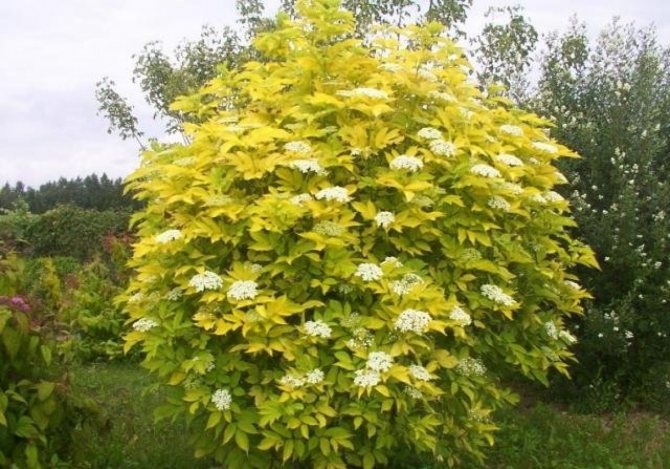

"Aureum" differs from other varieties of gordovina by its unusual color of leaves
Viburnum ordinary
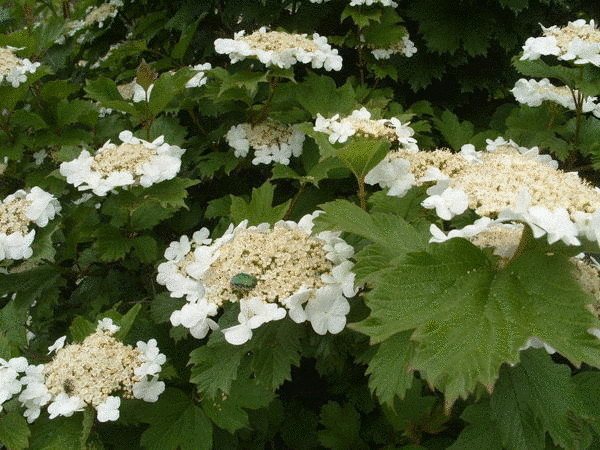

The very famous common viburnum (Viburnum opulus) is native to Eurasia. It is a spreading deciduous shrub up to 5 m high, up to 4 m wide. The leaves are spatulate, large, up to 10 cm long. The flowers are white, in flat inflorescences, the marginal flowers of which are sterile, with relatively large, white petals. Fruits - juicy red berries in loose, flattened clusters; touched by frost, they are edible with a peculiar taste and aroma.
Growing features
Shade-tolerant, moisture-loving, prefers fertile moist soils, but grows on rather dry loamy soils. On the southern coast of Crimea, it suffers somewhat from drought, but blossoms and bears fruit satisfactorily. Quite durable: it can live up to 50 years or more. Propagated by seeds, root suckers, cuttings. When sowing in autumn with freshly harvested seeds, shoots appear in 1.5 years. For spring sowing, a 6-month stratification in wet sand at a temperature of about 5 ° C is required. Seeds are planted to a depth of 2.5-3 cm. Germination rate varies from 40-90%. It develops normally only on constantly moist, fertile soils, in well-lit places. A beautiful, traditionally favorite ornamental shrub for single and group plantings. Its decorative form ‘Roseum’ is very effective - a form with completely sterile flowers in spherical inflorescences, 5-6 cm in diameter, which are greenish at first, then turn white and pinkish when flowering.
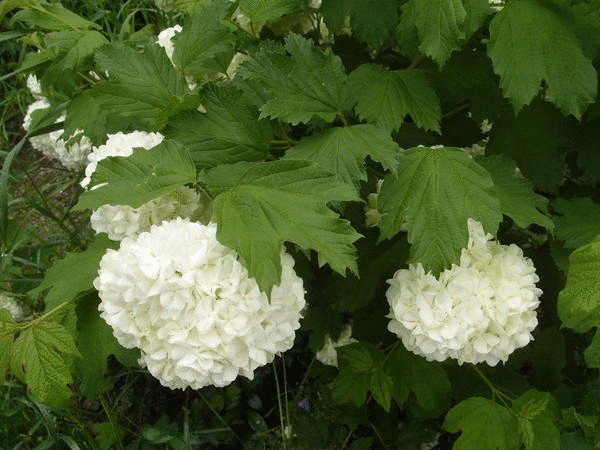

That is why its scientific name is ‘Pink’, while in common usage it is often called ‘Bulldonezh’ - a distorted French name ‘Snow Globe’. This form is less demanding on soil moisture and light. Luxurious viburnum for solitary and group plantings. Severely damaged by black viburnum aphid, rose leafworm. Suitable for planting on slides in groups or tapeworms. The formed standard specimens are very good.
Reproduction of viburnum
There are several ways to reproduce viburnum: by seeds, dividing the bush, using cuttings, vertical and horizontal layering.
Seed propagation
The seed method is used quite rarely for the following reasons:
- this is a rather lengthy process that can take more than 2 years;
- the method does not guarantee the preservation of the varietal characteristics of the plant.


Viburnum seed is flat and heart-shaped
The advantage of such reproduction is the viability and maximum adaptation of the obtained seedlings to the proposed growing conditions. If you sow the seeds in the fall, then the seedlings will appear only after a year. Then small seedlings must overwinter, and only after that they will enter the phase of active growth. This process can be accelerated by stratification:
- The seeds are placed in a humid environment. It can be sand, moss, or sawdust. Containers should be stored at room temperature. After about 2 months, the seeds will begin to hatch.
- Sprouted seeds are placed on the bottom shelf of the refrigerator and kept there for about a month. 3 months of artificial stratification replaces the year during which the seeds would germinate in natural conditions.
- Then the seeds are sown in a container filled with nutrient soil.
- If in the spring the seedlings have grown stronger, gained strength, 2-3 pairs of true leaves have developed on them, then it is recommended to plant them in a nursery located in the open ground. At the same time, they should be provided with regular watering, feeding and shelter for the winter.
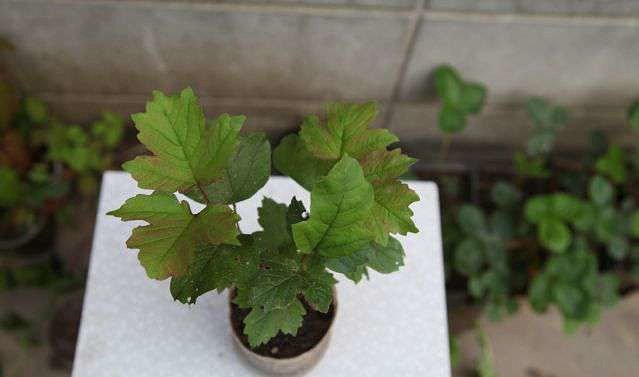

In open ground, you can plant a strong seedling that has several pairs of real leaves
- Weak seedlings are left in the planting container, placing it in the open air. It is recommended to plant the remaining seedlings in an open nursery after a year.
- After growing in a nursery, the strongest plants are planted in permanent places.
Viburnum seeds are characterized by poor germination: up to 20% of sowing.
Reproduction by dividing the bush
This method is most acceptable in the presence of a large bush of a good variety of viburnum, which requires transplantation to a new location. The dug out bush is divided into parts with a sharp tool. Root cuts are treated with charcoal. When dividing, make sure that there are at least 3 healthy kidneys in each part. Each part is planted in a separate planting hole, as when transplanting a plant. Viburnum can be propagated by dividing the bush in autumn and spring.
Propagation by cuttings
Cuttings are harvested in the middle of summer. At this time, the branches of the viburnum are particularly flexible, do not break. When cutting, make sure that each stalk is about 10 cm long and has at least 3 knots. The lower cut of the cutting is made oblique, the green leaves are removed. It is advisable to keep the planting material in any root formation stimulator.
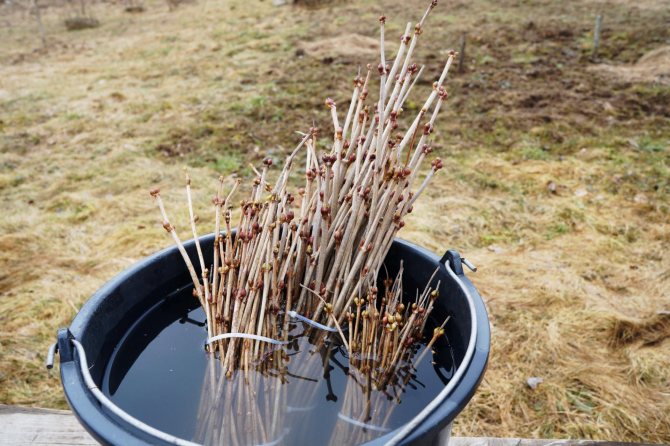

When using any rooting stimulant, you must strictly follow the instructions, since overdose is very dangerous
Then the harvested cuttings are buried 2 cm into the soil mixture, consisting of equal parts of river sand and peat. For good rooting, cuttings need a fairly high temperature (about 30 ° C), so it is better to plant them in a greenhouse. Cuttings need to be watered regularly, and for the winter, be sure to cover them with peat, sawdust or foliage. In the spring, grown healthy seedlings can be planted in a permanent place.
Reproduction by layering
Viburnum can be propagated by both horizontal and vertical layering. For horizontal layering, a mother branch close to the ground is selected, its top is cut off, bent to the ground, pinned with a wire or wooden hook and covered with soil. The top of the shoot is left not sprinkled.
Over the summer, the cuttings will give roots, and young branches will appear from the buds. The cuttings are separated from the parent branch, dug out together with a lump of earth and planted in a permanent place.
It is easy to propagate viburnum with vertical layering. Such reproduction includes the following stages:
- In autumn, the lower branches of a young viburnum bush are cut off, leaving at least 4 buds on them.
- Hilling bushes is carried out.
- In the spring, the shoots that have emerged from the buds are again covered with earth.
- After the shoots grow back up to 25 cm, they can be separated from the mother plant and planted in a new place.
Video: reproduction of viburnum by layering
Kalina useful
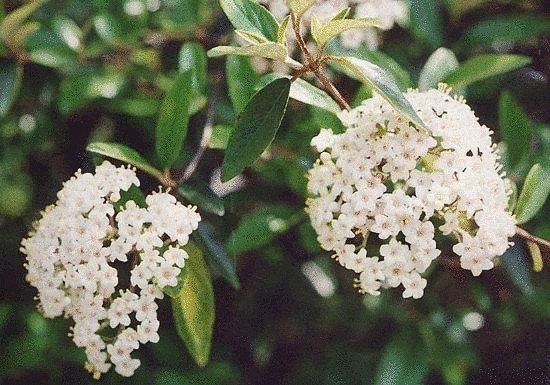

Kalina useful (Viburnum utile) comes from Central China. It is an evergreen shrub, up to 1.5 m high. The leaves are elliptical-ovate, 2-7 cm long. The flowers are white, fragrant, collected in dense, stellate-pubescent shields, 5-8 cm in diameter; bloom in April-May. The fruits are bluish-black.
Growing features
Prefers a semi-shady location, requires improvement of local soil conditions and watering in summer. It does not tolerate a lack of soil moisture, especially in sunny locations: in such cases, shedding of leaves is observed. Suitable for planting along walls, curbs and groups. It is practically not damaged by pests.
Kalina: varieties and tips for growing
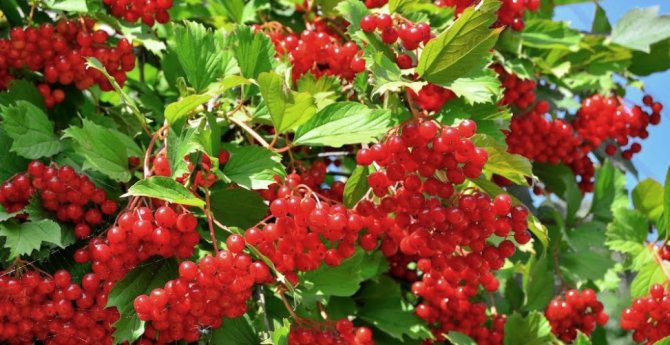

The genus Kalina (Viburnum) itself unites about 170 species - shrubs or small trees.Inhabitant of the temperate zone in the northern hemisphere, but also found in the Andes, in the Antilles, in Madagascar. It is believed that the word "viburnum" comes either from the Proto-Slavic or from the ancient Indian languages. In the first version - the origin from the word kal (wet earth, mud, swamp), because of the moisture-loving viburnum; or from kaliti (to heat, harden), because of the color of the berries. According to one of the legends, viburnum is a girl who loved her homeland, who was killed by her betrothed, who went over to the side of the enemy. White viburnum flowers - innocence, red berries - blood (bitter, like her fate, but giving strength and health to all who love their native land). Indeed, almost all parts of the viburnum are healing: bark, berries, seeds, flowers, and branches.
Healing properties
Everyone knows that the common viburnum is useful, but few people know the entire huge list of its capabilities. Viburnum preparations have excellent tonic, astringent, hemostatic, diuretic and antispasmodic properties. With the help of fruits, they lower blood pressure, strengthen the immune system. A decoction with the addition of honey is used for respiratory diseases. Viburnum juice relieves pain in case of heart and liver problems. Infusions of leaves and flowers (5 and 10%) are a very effective antiseptic. A decoction of the bark is used for convulsions, neuroses and insomnia, and is especially useful for colds.
viburnum - a symbol of the Motherland
About growing viburnum in the garden
Viburnum vulgaris is an unpretentious plant, however, for its successful cultivation, it is advisable to know some tricks. For example, if in nature viburnum most often grows in humid places, then in culture it prefers drier soils with a low groundwater level. Viburnum can be planted both in autumn and spring, preferably in lightened places with a neutral or slightly acidic reaction of the soil, the fertility of which determines the splendor of flowering and fruiting. A month before planting, the soil is fertilized with phosphorus-potassium fertilizers and peat. A group of bushes is placed at a distance of about 3 meters.
Viburnum can be planted both in autumn and spring, preferably in lightened places with a neutral or slightly acidic soil reaction.
With the onset of summer, viburnum will delight you with inflorescences of white or pale pink. With the onset of autumn, its delicate foliage is painted in luxurious shades of yellow, pink, orange and crimson red. Reproduction by seeds. Some experienced gardeners prefer planting material from seed. Seeds are taken from fruitful trees, from the largest and sweetest berries. They can be planted in the fall of the same year, however, such seeds will sprout only at the end of next summer, and will begin to grow actively only in the spring of the second year. For faster germination, stratification is necessary, in which seeds are artificially kept for a long time at a certain low temperature, thereby increasing germination. Propagation by cuttings. Vegetatively, viburnum is propagated by layering or petioles, harvesting them in early July by dividing the bush. For annual shoots, grooves are prepared in the spring, shoots are laid in them, sprinkled with earth and fixed with wire, leaving the top not buried. The above-ground part of the cut is pulled over and cut, and by the autumn they have roots sprouting and shoots appear. The period for harvesting the petioles is June or early July, the length is at least three knots. You can root the petioles not only in the greenhouse, but also at home, in flower pots. In this case, the soil is prepared from humus, sand and sod land in a ratio of 1: 1: 3, and a layer of river sand is poured on top. For a home option, a semblance of a greenhouse is also arranged: the pot is covered with a film or glass jar. When transplanting, the bush is divided into several parts, on each of which three or four renewal buds must be preserved. Transplanting works are performed in spring and autumn. The seedlings obtained by vegetative propagation begin to bear fruit after a year.
Care Tips
Watering. During the dry period, the viburnum needs watering. Young seedlings are watered in the evening, soaking the soil with water to a depth of 40 cm. Watering of adult bushes is given special attention during the growing season and ripening of berries. Fertilizers. Before blooming the leaves, the viburnum is fertilized with urea. Before flowering - potassium sulphide or wood ash. In the middle of summer, complex fertilizers are applied, every 2 years, when digging the soil around the bush, phosphorus-potassium fertilizers and rotted manure are applied. Forming. Pruning is recommended in spring, rejuvenating - 6 years after planting, leaving up to 15 main branches. In the case of a weak or almost non-flowering bush, pruning to a height of about 20 cm from the ground saves. For a lush, beautiful flowering, shoots longer than 40 cm are pinched by hand. For a year, viburnum shoots can grow up to 40 cm. The crown must be formed, removing unnecessary and diseased branches.
Viburnum varieties in ornamental gardening
Kalina Roseum (Roseum, Buldenezh, Snow Globe). Everyone is familiar, with increased decorative qualities, a variety that does not form berries, with inflorescences-balls hanging at the ends of branches and changing color during flowering: from green to white, and then to pinkish. Kalina Nanum (Nanum). A dwarf decorative form up to 1 m high with small openwork leaves. Young leaves of viburnum Nanum have a reddish tint. Kalina Aureum (Aureum). Plant with unusual golden foliage and deep red fruits, 1–2 m tall.
Viburnum folded
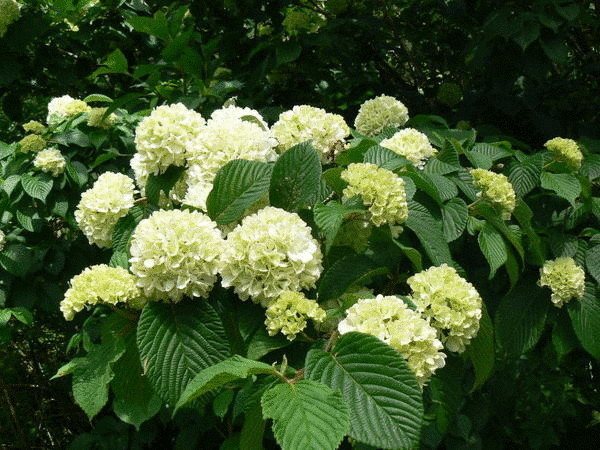

East Asian beauty - folded viburnum (Viburnum plicatum), homeland - China, Japan, Taiwan. It is a deciduous shrub with arched drooping branches, 3 m high and 4 m wide. The leaves are ovoid-oval, folded with leaves. The inflorescences are very similar to the inflorescences of the common viburnum, but they are located on the branches in pairs along the entire length of the shoots, which is why this viburnum is very elegant at the time of flowering. Forms fruit rarely. There are decorative forms.
Growing features
Propagated by cuttings. This viburnum is not demanding on growing conditions, but the most lush bushes are obtained when planted in lighted places with fertile, drained soil. A beautiful plant for tapeworms and groups.
Contraindications to the use of red viburnum
The use of red viburnum is contraindicated for people with increased blood clotting and prone to the formation of blood clots. Its use is contraindicated in hypotensive patients - people with low blood pressure. Use with increased acidity of gastric juice is contraindicated. Do not use it during pregnancy and breastfeeding.
Before use, a consultation with a doctor is required !!!
If you have experience in using this plant, please do not be lazy and leave a comment on the article !!!
Kalina Farrera, or fragrant
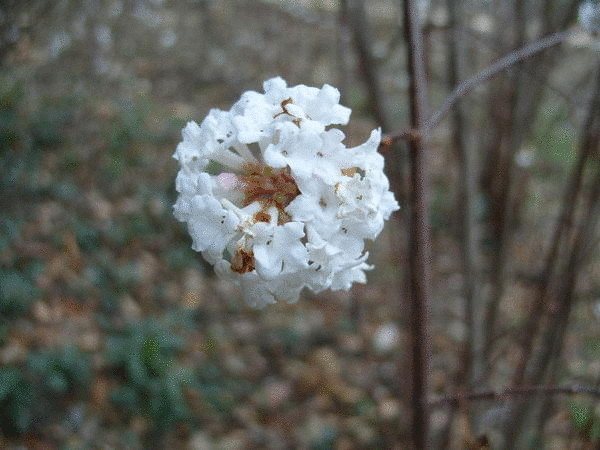

Chinese fragrant beauty - Farrera viburnum (Viburnum farreri, syn.V. fragrans), homeland: North China. It is a deciduous shrub, up to 3 m high and up to 2.5 m wide. Leaves are elliptical, up to 10 cm long. Flowers from white to pink, fragrant, collected in inflorescences, up to 5 cm in diameter; bloom in winter, early spring.
Growing features
It is winter hardy enough: it can withstand a drop in temperature to -15 degrees C. It is undemanding under culture conditions. It is slightly damaged by pests. Suitable for single planting and in groups. For rejuvenation, all old branches are cut at a level of 15-20 cm from the soil surface. Propagated by seeds, layering and cuttings, both green and lignified.
Features of planting and transplanting a viburnum bush
When choosing a place for planting viburnum, focus on areas with partial shade, with neutral or slightly acidic, well-moistened soil. Viburnum will grow on sandy and podzolic infertile soils, but you will not get a good harvest.
The viburnum grows best on the banks of streams, rivers, artificial reservoirs.
A month before planting, it is recommended to add peat and phosphorus-potassium fertilizers to the soil. Planting a viburnum seedling can be carried out in spring or autumn, guided by the following technology:
- Dig a planting hole about 50x50x50 cm in size.When several plants are planted, a distance of at least 3 m is provided between them.
- The upper fertile soil layer is mixed with peat or humus (1 bucket per planting pit), add 3 tbsp to the mixture. l. urea and 0.5 liters of ash or dolomite flour.
- The seedling is placed vertically in the center of the pit, observing the location of the root collar. It can be deepened by no more than 5 cm.
- The pit with the seedling is covered with prepared soil mixture.
- A hole for watering is organized around the seedling. The initial watering should be abundant (about 30 liters of water).
- The trunk circle is mulched with sawdust, peat.
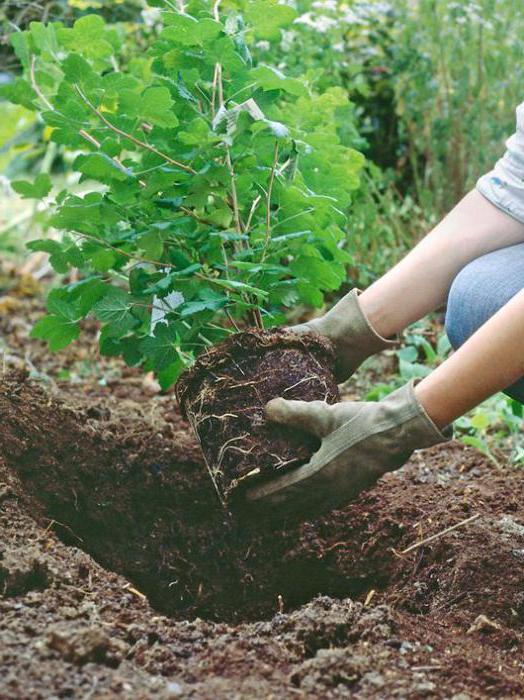

Viburnum seedling needs to be removed from the container and carefully spread the roots
Viburnum transplant
If the viburnum has been planted for a long time, but it grows poorly and bears fruit, you need to think about transplanting the plant. It is necessary in the following cases:
- Kalina does not have enough space for normal growth and development. It is oppressed by outbuildings and other plantings;
- the site is not comfortable for the plant in terms of illumination parameters. The bright midday sun dries up the soil, a strong shade negatively affects the health of the plant;
- as a seedling, you use a fairly mature plant (you took it from friends, neighbors, dug wild viburnum in the forest).
The transplant can be carried out in spring, autumn or summer, following simple rules:
Recent Entries
Rose Petal Jam and Its 7 Health Benefits You Likely Didn't Know About What Fruit Are You According to the Zodiac Sign 11 Best Grape Varieties That Will Help You Create Unique Homemade Wine
- Preparing a plant for transplanting. It is desirable for the tree to be young and healthy. Damaged branches are removed from it, and then a bush is dug around the trunk. They do this carefully and carefully, trying not to harm the root system. If necessary, remove the thickest root processes, lubricating the cut with charcoal.
- We are preparing a place for a transplant. We dig a planting hole, focusing on the size of the root system, but not less than 50x50x50 cm. To backfill the transplanted plant, we use a soil mixture, which we prepare, as for planting a viburnum seedling.
- After the seedling is sprinkled with earth and the soil around is trampled, at least 2 buckets of water are poured into the hole. This will help compact the soil and remove possible voids.
- If the transplant is carried out in the fall, then, in addition to mulching, it is recommended to insulate, cover the plant for the winter.
- The transplanted plant needs to be pruned. For autumn planting, this procedure can be postponed until spring. Damaged, dry branches are cut at the root, and the rest - 20-25 cm above ground level. This pruning will help rejuvenate the transplanted bush.


If, after transplanting, the viburnum still does not bloom well, it can be cut almost at the root, leaving the trunk and branches 20 cm from the ground
A few facts about viburnums that you did not know yet:
- Have you noticed that the common viburnum leaves resemble maple leaves? Hence the Latin name of the genus Viburnum - the Roman designation of the common maple, which emphasizes the external similarity of the leaves of these two plants.
- Viburnum seeds germinate only after a year with autumn and spring sowing, therefore, late summer sowing is recommended from mid-August.
- Most viburnums have edible fruits, they contain a significant amount of organic acids, vitamins and about 15 different chemical elements valuable for the human body.
- The bark, leaves, flowers and fruits of some types of viburnum have long been widely used in medicine.
- Viburnums are decorative, dust- and gas-resistant, some species withstand drought and salinization of soils, tolerate pruning of branches well, allowing the formation of various types of crowns.They have a high regenerative capacity, therefore they are used to create roadside snow-collecting strips in field-protective afforestation, to consolidate the soils of mountain slopes and as undergrowth to attract birds to plantations.
Kalina red useful medicinal properties
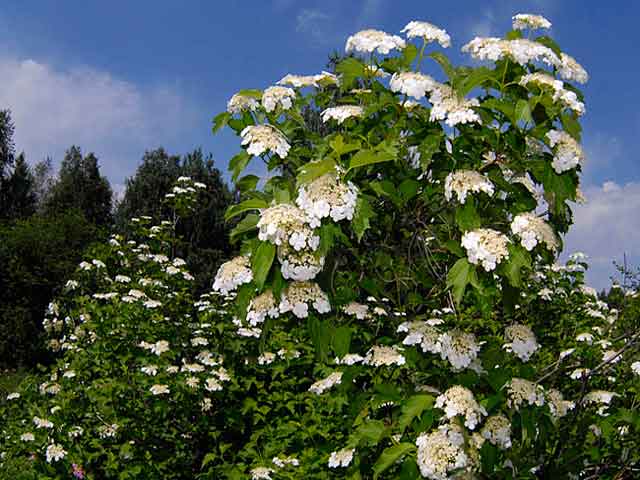

The fruits of red viburnum contain up to 32 percent invert sugar, 2 percent acids, up to three percent tannins, ascorbic acid. The bitter taste of the berries is given by the glycoside viburnin, which has a therapeutic effect. Obviously, therefore, selected forms of red viburnum with sweet fruits have less therapeutic effect.
The bark of red viburnum contains up to 6 percent of resins, they include various organic acids, tannins, flavonoids, vitamins C and K.
Red viburnum preparations lower blood pressure, accelerate wound healing and have a hemostatic effect, improve heart function, have a diuretic and choleretic effect.
Placement of viburnum in the country
Viburnums in bloom are so self-sufficient that they can well cope with the role of the May dominant in their summer cottage.
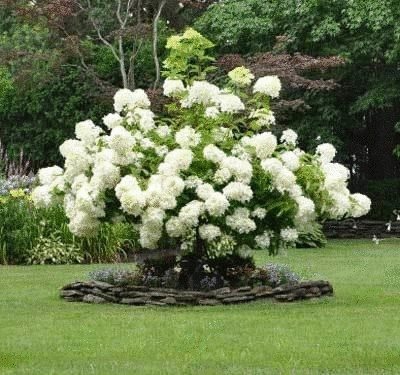

The most beloved viburnum is planted next to the house.
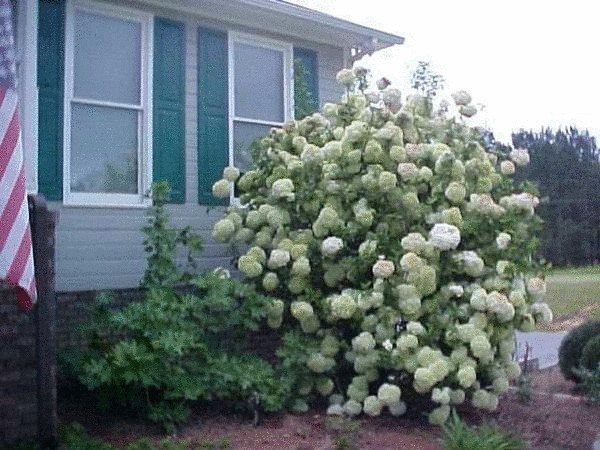

A peculiar arch made of blooming viburnum can even decorate a May wedding.
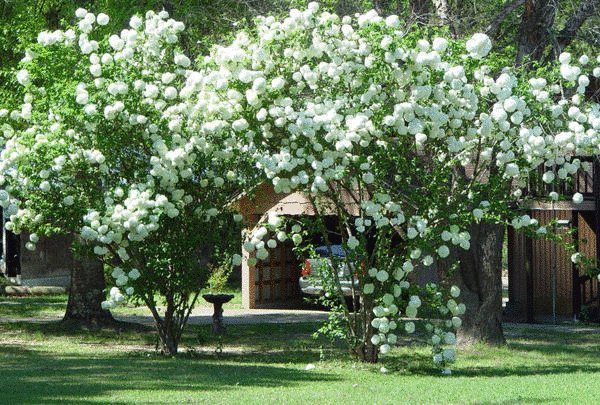

True admirers of viburnums admire them in the garden.
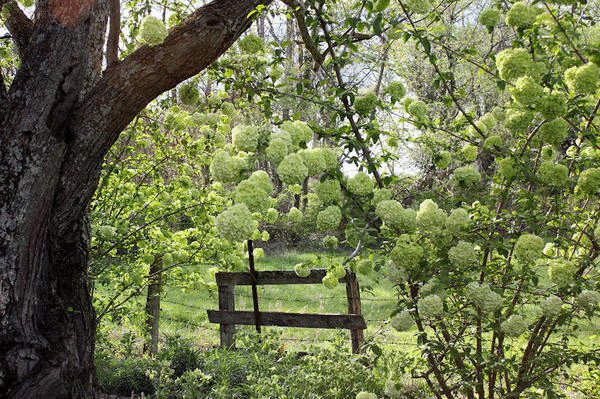

They decorate interiors in May with viburnum bouquets.
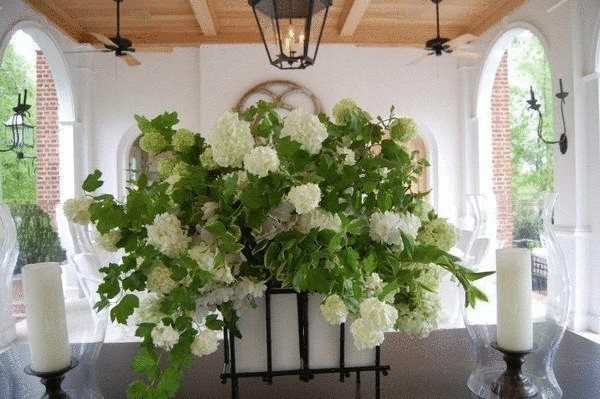

Scientists have bred several varieties of viburnum without bitterness
In Russian folklore, as you know, two berries are mentioned more often than others. Raspberries represent a sweet, happy life. And viburnum is a bitter fate. This comparison is based on the taste of the fruit. But scientists decided to break stereotypes and bred several varieties of viburnum that have no bitterness.
More precisely, there is almost no bitterness, because no one has yet been able to get 100% sweet viburnum. But compared to wild ancestors, the fruits of some varieties have a barely noticeable bitterness. True, the tasters are cautious, although they give a high mark for the viburnum - 4 points (out of 5 possible), but the taste is called slightly bitter. Meanwhile, some berries contain quite a lot of sugar.
This is the sweetest variety of viburnum - 14% sugar in berries. And his score is more than high - 4.2 points. Because everything is in moderation here: a little sourness, a little bitterness, as a result, a completely balanced pleasant taste is obtained.
Fruits and Vigorovskaya are bright red, weighing 0.5-1.5 g. Productivity 6-10 kg per bush.
The plant itself is of medium height - up to 3 meters. Looks very elegant in autumn, when the leaves become brightly colored.
Unfortunately, reference books do not indicate the amount of sugar in the fruits of this variety. But tasters rate the taste as “sweetish-sour, with light astringency, almost no bitterness” and boldly give 4.2 points, adding that the berries are also very aromatic.
Mary's fruits are light red, weighing about 0.6 g. An average of 8 kg can be harvested from one plant.
The bush grows up to 5 m. It does not get sick and is almost not affected by pests. It looks very impressive in the fall, when the leaves turn crimson-golden.
By the amount of sugar it takes the second place - it is 13% in fruits. Experts estimate the taste at 4 points, marked "sweetish, slightly bitter."
Ulgen's fruits are medium-sized, about 0.7 g, but they are collected in very large spectacular brushes - 35-50 pieces each! And they also have a lot of vitamin C - 130 mg (in wild viburnum about 50 mg). Productivity 9-11 kg per bush.
The plant is quite tall - up to 4 m, and sometimes even taller. Loves watering. The variety is resistant to diseases and aphids.
V
"Ulgen" in translation from Altai means "good spirit".
Here, too, the question arises with the amount of sugar in the fruits, but we will believe the tasters. And they write that the taste of this variety is “sweet and sour, with a little pleasant bitterness,” and give a solid four.
The fruits of the Red cluster are bright red, weighing 0.75 g. Low yield - 2.5-4 kg per bush. But the berries are very healing - they contain vitamin C as much as 140 mg! This is the highest among sweet viburnum.
The bush grows compact, no higher than 3 m, does not get sick, is not affected by pests. In the fall, it glows in the garden with a crimson-scarlet dress of leaves.
In the berries of this type of sugar 11.8%. Taste - 4 points, "slightly bitter, almost sweet."
The fruits, unlike most other varieties, are not round, but oval, weighing 0.6 g. Productivity - 6 kg per bush.
Zholobovskaya is ideal for small gardens, since the bushes of this variety are very compact and low - no more than 2 m.
Almost all of the listed viburnum varieties require pollinators. And in order to get a good harvest of useful berries every year, 2-3 different varieties must be planted on the site.
And the yield of viburnum is highly dependent on the weather and care. This culture bears fruit abundantly only in sunny areas, with regular watering and feeding.
TRICKY QUESTION
Oleg Smirnov, Samara: “I've heard that bitter viburnum is much healthier than sweet one. Is it so?"
Partly yes. The bitterness of viburnum berries is given by iridoids - biologically active substances that increase appetite and improve digestion. In addition, they kill harmful microbes in the body.
But then another problem arises: you can't take such a viburnum in your mouth. And there are hardly many extreme sportsmen who, for the sake of benefit, will chew bitter berries. And so that the fruits become edible, many summer residents freeze them. But after that, valuable iridoids disappear, and with them also vitamin C.
There is much less useful bitterness in the berries of sweet viburnum, but it is there. This means that there will be benefits from it. Moreover, berries can be safely eaten fresh. As a result, it turns out that sweet varieties provide more benefits to the body than bitter ones.
Pruning
Pruning correctly helps to form a healthy plant and produce large berry yields.
Sanitary
After a frosty winter, sanitary pruning is carried out.
At the same time, all frozen and dried shoots, as well as branches with signs of various diseases, are removed.
Thinning
Thinning pruning involves removing thickened areas and pruning malformed branches.
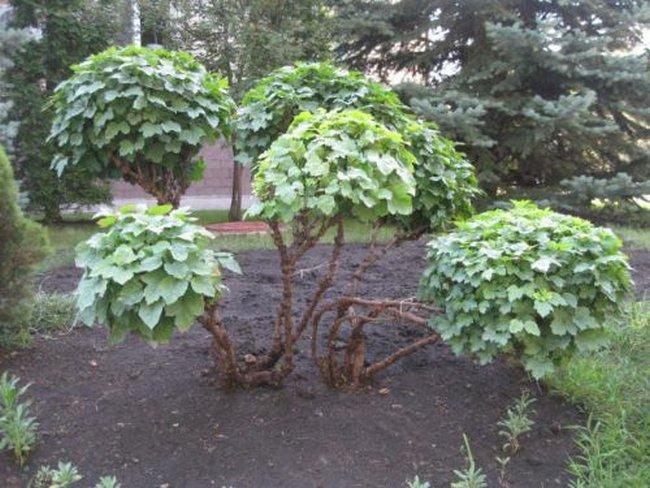

Formative
Every spring, the strong shoots are shortened to stimulate the development of the lateral ones.
Rejuvenating
Anti-aging pruning is carried out no more than once every five years. In this case, all old branches are removed, leaving about 20 of the strongest shoots. Weak flowering bushes are best cut completely at a height of 30 cm from the root collar.
Buryat or black (Viburnum burejaeticum)
The species is represented by a highly branching spreading shrub that can grow up to 3 meters in height. It has bare, yellowish-gray branches and bark of the same color. Over the years, it cracks, and it becomes cork.
The plant has sharp leaves, the top of which is dark green and the bottom is light green. The flowers are nondescript, small in size, yellow-white in color. Gathering together, they form corymbose inflorescences.
Ripening of black berries occurs in September, but they become edible only after the end of the frost.
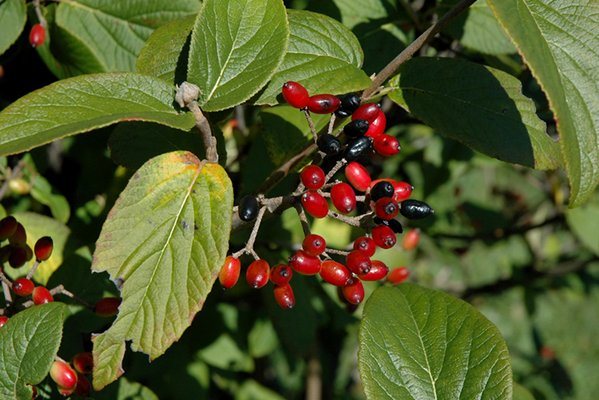

Viburnum black has good winter hardiness, grows well on clay soils and illuminated areas. In urban conditions, it quickly dies. The species will take root well if you plant it on the shore of a reservoir, in a park, a forest park.
Viburnum hedge
In rural areas, gardeners plant viburnum around the perimeter of their land. Such a planting creates a hedge, which pleases with its beauty during flowering and ripening of berries. Therefore, if you want viburnum to grow at your dacha (a tree or shrub, we already have an idea), you can use a similar planting principle.
It is worth noting that viburnum, regardless of the variety, goes well with other garden plants, so with its help you can perfectly decorate your garden plot.
Common or red (Viburnum opulus)
Most often, this species is found on the edges, banks of rivers, lakes, inhabits deciduous and mixed forests.It has large green leaves that form frills, similar to a ballerina's tutu.
It has many large inflorescences, their diameter is 10-12 cm. The edge is represented by large flowers with snow-white corollas, and small and inconspicuous ones are placed in the center - thanks to them, berries are tied on the bush. The first (large) ones attract pollinators.
Important! You should not plant viburnum in the shade - at first the shrub will grow slowly, but soon it will stop blooming and die. Kalina loves good lighting.
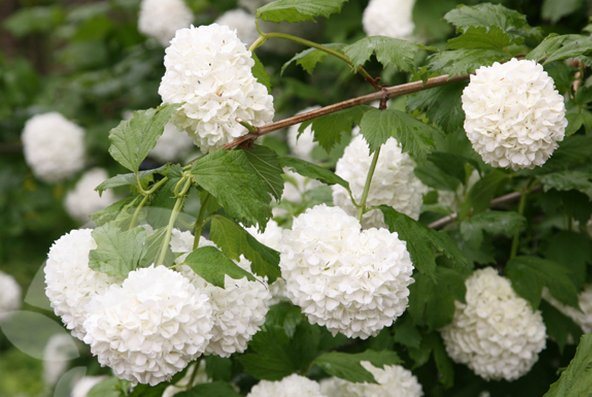

The shrub blooms in late May - early summer. The berries ripen in August-September. They are quite juicy, have a round or elliptical shape, yellow flesh and a flat large bone; suitable for human consumption.
It is better to pick berries after the first frosts are over - by this time they will lose their bitterness and astringency. Viburnum red, the photo of which you will find in this article, is the most common species.
The biological relative of viburnum is elderberry - they belong to the Adoksovye family.
Viburnum vulgaris includes a large number of varieties, among which are especially popular:
- "Taiga rubies";
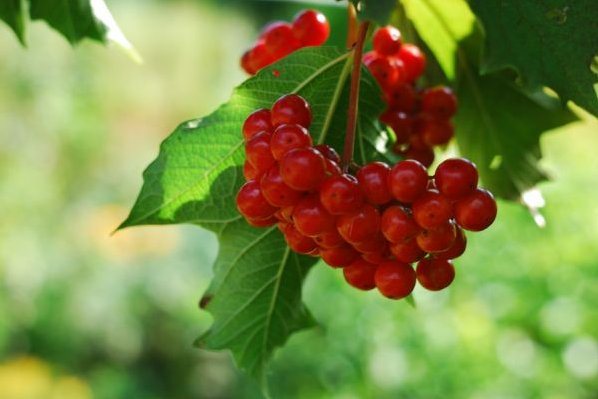

- "Nanum";
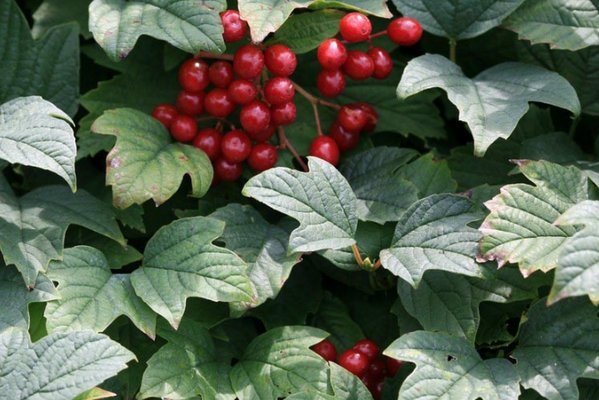

- Roseum;
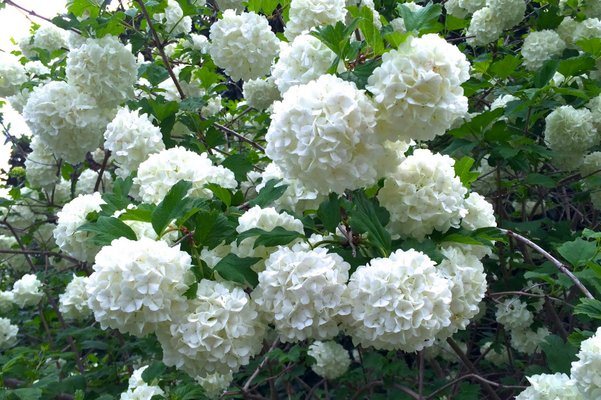

- "Compactum";
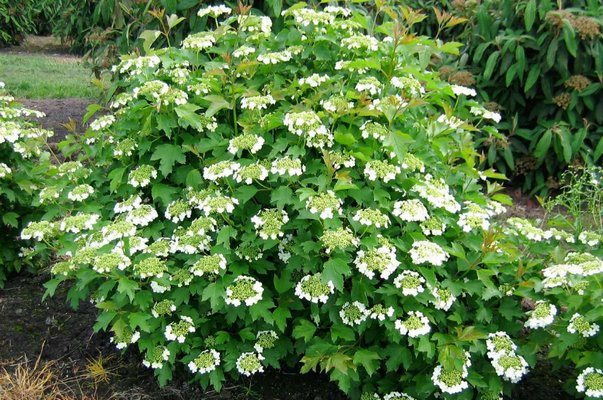

- "Zarnitsa";
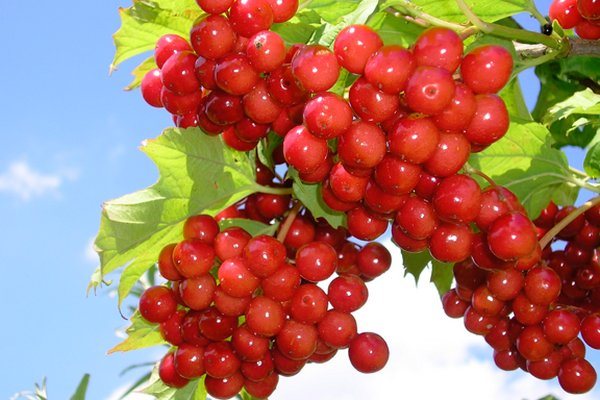

- "Variegata".
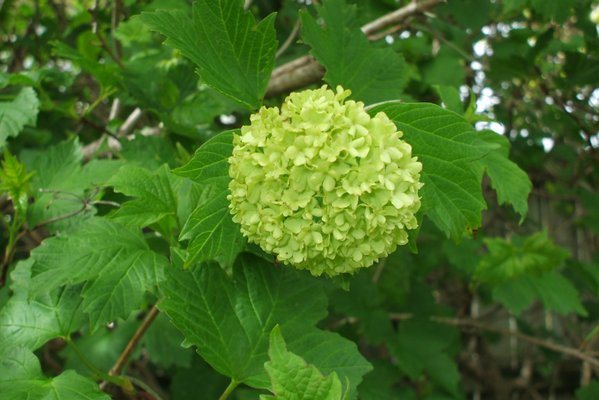

If you are looking for frost-resistant varieties, pay attention to viburnum
- "Zholobovskaya"
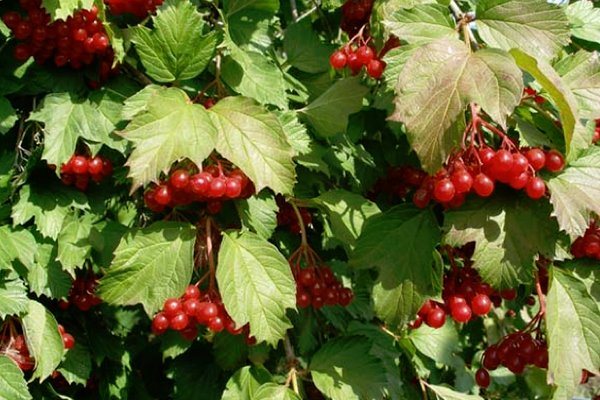

- "Souzga"
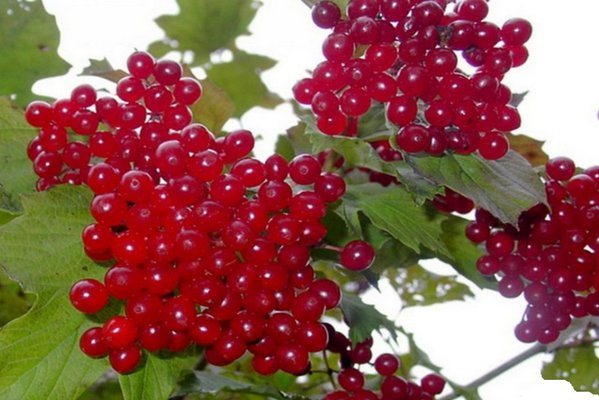

- "Ulgen"
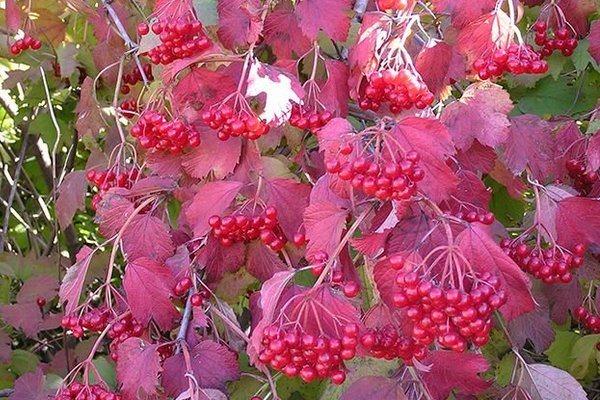

Check out the intricacies of harvesting viburnum for the winter.
The nuances of choosing a culture
The common viburnum is widespread on the territory of Russia, on the basis of which the best breeding representatives are derived. For lovers of sweet cultures, sweet-fruited viburnum is bred. These varieties are distinguished by the absence of the usual bitterness of viburnum, although the supply of nutrients remains at the same level.
The choice of a variety depends on the climatic conditions of the region:
- for the Moscow region, remontant species are suitable, such as: Souzga, Taiga rubies;
- for areas with low winter temperatures: Ryabinushka, Zarnitsa, Sunset;
- sweet-fruited varieties grow in the southern regions: Vigorskaya, Shukshinskaya.
Toothed (Viburnum dentatum)
It is represented by a deciduous bush, the height of which reaches 4.5 meters. It has erect branches painted in ash gray color. The shoots are bare, have a smooth structure. The length of the leaves is 4-10 cm, they are characterized by an oval shape and a rounded or weakly cordate base.
The plant has flowers of the same type, the diameter of which is 0.4 cm. They are painted white and gather in dense shields. The size of the fruit is 0.6 cm in diameter, the shape is round-ovoid, the color is blue-black. Blooms in May and June. The plant has good frost resistance.
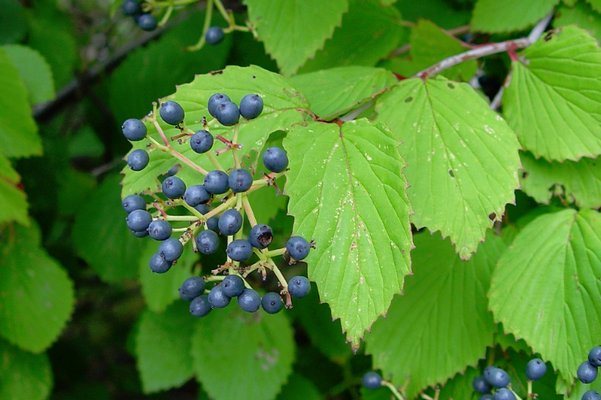

Harvesting, storage and procurement
Different varieties ripen in different ways, so it is necessary to start harvesting based on the ripening period of the berries of a particular variety of viburnum. Most often, the berries are completely ready for picking in early or mid-autumn. The berries are trimmed with garden shears and stored in the freezer. Berries are great for making jam or juice, which have a unique taste and aroma. In addition, the berries can be grated with sugar, placed in airtight containers and used in winter to make medicinal tea.
Fork (Viburnum furcatum Blume)
It grows on mountain slopes, in coniferous and mixed forests. The shrub has beautiful large leaves, bright white flowers and red fruits. In the spring, the leaves are colored red-brown, and in the fall they acquire a bright purple tint.
Did you know? The tree got its name due to its bright red berries, which, as it were, “glow” in the light.
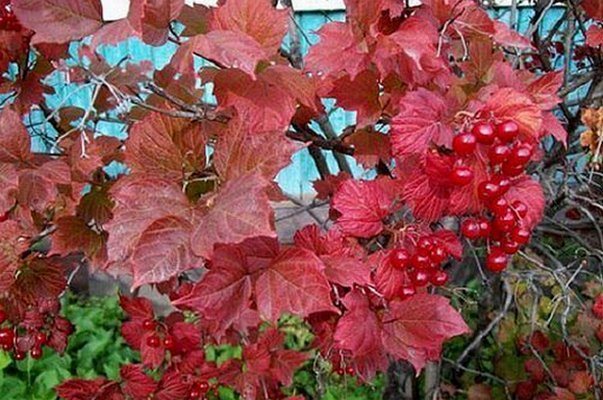

The bush reaches a height of 4 meters, has forked branching. It has thin rounded ovoid leaves. The leaf surface is yellowish-green in color.
With the arrival of autumn, they turn into a lilac-crimson color, which gives the plant an extraordinary beauty. The flowers are white and form umbellate inflorescences.
The composition and calorie content of viburnum
The energy value of red fruits is 26.3 kcal per 100 g. There are no fats and proteins in them, and the amount of carbohydrates is 7 g.
Essential vitamins:
- C - 82 mg;
- A - 2.5 mg;
- carotene - 1.4 mg.
Basic minerals:
- potassium - 197.5 mg;
- magnesium - 17.5 mg;
- calcium - 40.5 mg;
- iron - 6.1 mg.
The leaves, bark, unripe fruits contain saponins, oxalates, bitter substances, tannins, viburnin glycoside, ascorbic and oleic acids, and a lot of pectin.
Viburnum prunifolia
Kalina of this species can be found on the slopes of hills, river banks. Many are interested in the question: is the viburnum a tree or a shrub? If we take into account the size of a plant of this species, then we can conclude that viburnum is a tree.
The height is up to 5 meters. However, most often the plant can be found in the form of a shrub. Has strong horizontally spaced branches, bare shoots. The leaves are elliptical in shape, their length is 4-8 cm.
The flowers are pure white in color, their diameter is 0.6 cm. The shape of the fruits is oval, the size is up to 1.2 cm, the color is blue-black.
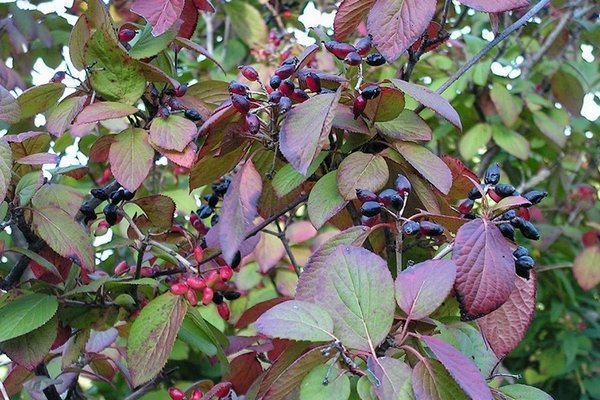

Did you know? Viburnum can be used as a dye. To do this, the wool is dipped in concentrated juice, and after a few hours the thing turns red.
The flowering period begins in early June, fruiting occurs in September. Possesses good winter hardiness.
Three-lobed (Viburnum trilobum Marsh)
The ideal place for the growth of this species are humid forests, thickets of bushes, river banks.
The main difference from ordinary viburnum is the lighter color of the foliage, the fall of which also occurs much earlier. The maximum plant height can reach 4-4.5 meters, the crown in diameter is 2.7-3.5 meters. In the fall, the foliage takes on a purple hue.
During flowering, the bush looks very elegant. The size of the berries is about 10 mm. They taste very much like black currants.
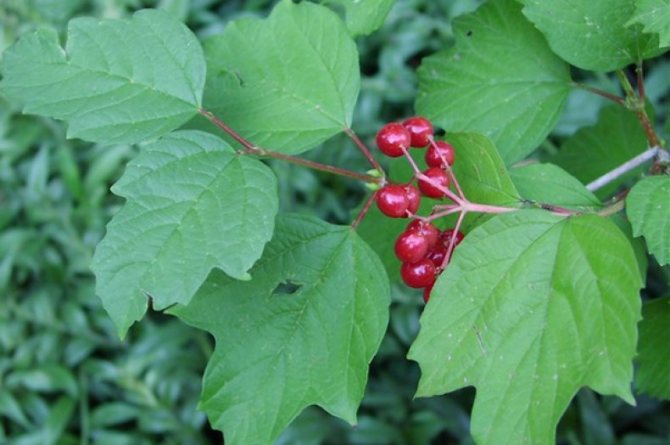

Now you know what the different species are and how viburnum blooms. Based on the information received, you can easily choose a shrub that will be a wonderful decoration for your summer cottage.
Recipes
Jelly from viburnum
Ingredients:
- 2 glasses of water;
- 1 kg of viburnum;
- 800 g of sugar.
Preparation:
- Rinse the fruit in a colander under running water.
- Dip the berries in boiling water for 5 minutes to soften and lose their bitterness.
- Grind the viburnum through a sieve, add water and sugar to the juice. Mix thoroughly.
- Cook over low heat for 50 minutes, until thickened well.
- Pour the jelly into jars and store in the refrigerator.


Viburnum sauce for meat
Ingredients:
- 3 cloves of garlic;
- 5 sprigs of purple basil;
- 6 sprigs of dill;
- 300 g of viburnum;
- 2 tbsp. l. Sahara;
- 200 ml of water;
- 1 hot pepper;
- 3 pinches of salt.
Preparation:
- Rinse the berries, pour into a saucepan and cover with water.
- Cook over low heat until it boils.
- Reduce heat to low and cook berries for another 15 minutes.
- When the viburnum has cooled, rub through a fine sieve.
- Put the sauce on low heat, add crushed garlic and chopped pepper.
- Finely chop the greens and add to the mass, put sugar and salt.
- Mix the sauce well and bring to a boil, keep on low heat for another 5 minutes.
- Pour the prepared sauce into a jar.


Useful and medicinal properties of viburnum
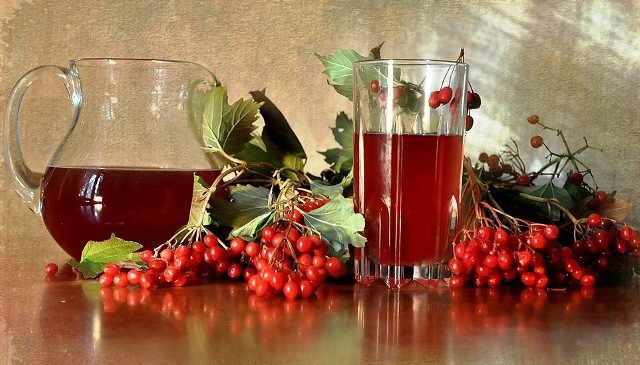

The useful and healing properties of the common viburnum are as follows:
fruits -
- hypotensive,
- disinfectant,
- anti-inflammatory,
- wound healing,
- anticonvulsant,
- antifebrile,
- diaphoretic,
- sedative (sedative),
- diuretic (diuretic),
- choleretic,
- laxative,
- vitamin,
- fortifying;
bark -
- hypotensive,
- antiseptic,
- hemostatic,
- hemostatic,
- antispasmodic,
- sedative (sedative);
flowers -
- diaphoretic,
- expectorant
- astringent (for diarrhea);
leaves -
- firming (juice) - after serious illness,
- anthelmintic, etc.
Storage
Kalina for the winter is harvested in dried, frozen and dried form, grind with sugar.At the same time, the berries retain their beneficial properties. You can dry them in bunches, tying them in bouquets and hanging them in the cellar or in the attic. Fresh viburnum is stored for a long time in the refrigerator, in spacious containers.
Dried viburnum
- rinse ripe fruits and remove the stalks;
- blanch the viburnum for 3 minutes to remove the bitterness;
- dry some berries and sprinkle with sugar (for 1 kg of fruit you need 250 g of sugar);
- leave the viburnum in sugar for a day at room temperature;
- drain the juice, sprinkle the fruits with sugar again and leave for a day, drain the juice;
- the remaining juice can be preserved. Pour berries with hot syrup from water and sugar, leave for 5 minutes, strain;
- put the viburnum in a thin layer on a baking sheet and stir for 30 minutes in an oven preheated to 85 degrees;
- pack ready berries in jars and close tightly.
Dried viburnum
- rinse the berries together with the stalks, and then carefully remove the stalks;
- evenly spread the wedge on a tray or baking sheet;
- dry in the oven with the door open at a temperature of 60 degrees;
- store in linen bags or glass jars.


Why is viburnum useful for men
The frantic pace of life engulfs modern men. Unhealthy food, bad habits and a frivolous attitude towards one's health all lead to sad consequences - a sick heart and liver, high blood pressure, nervousness, and sexual problems.
Of course, the best thing would be - proper nutrition and a clear daily routine. But few of the stronger sex cares about this.
Today in the arsenal of pharmacology there is a sufficient range of complexes that prevent the development of heart diseases. For men who want to support themselves, a unique plant is suitable - Viburnum vulgaris, because its composition contains just those substances that will help improve and maintain the physical condition of the body.
- Strengthen immunity and potency.
- Normalize the work of the heart, stabilize blood pressure.
- Eliminate chronic fatigue syndrome.
Kalina red is a fortifying natural remedy, and even if a man leads a healthy lifestyle, then one should not forget about the environmental problems of our regions. This berry is a lifesaver for residents of megalopolises.
Again, remember the contraindications, if there are alarming symptoms, first of all we go to see a doctor.
Gordovina (Viburnum lantana)
Quite a well-known species that has black edible fruits. Outwardly, it practically does not differ from the viburnum ordinary. It is represented by a dense shrub with a dense compact crown. The height of the plant can be 5-6 meters, the crown grows up to 5 meters in diameter.
White hairs can be seen on the leaves and shoots, which gave rise to the popular name "flour plant". The foliage is oval, dark green on top, grayish underneath.
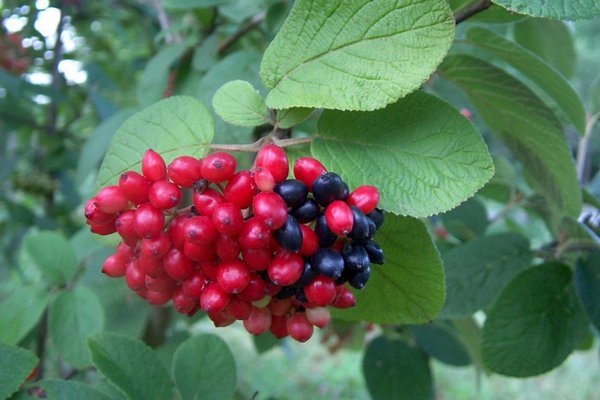

Viburnum "Gordovina" blooms in May-June for 2-3 weeks. Ripening, the berries slowly change their color: from bright red they gradually turn black.
What varieties are there?
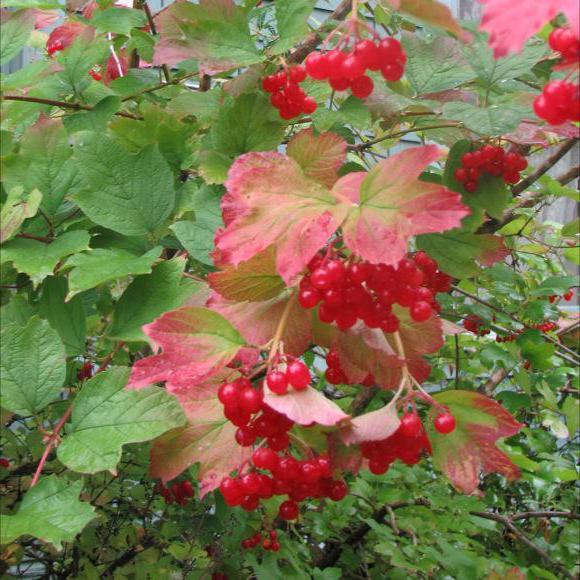

In nature, there are about 200 varieties of this berry shrub, among which there are those in which the berries may not be red, but different, for example, black. Thanks to the efforts of breeders, today there are varieties with large berries, with high yields and excellent healing properties. Let's look at the most common varieties that the vast majority of gardeners grow in their gardens.
General information about Kalina
In Russia, viburnum has been known for a long time, it is ranked among the primordial Russian cultures along with mountain ash and birch. Real breeding work was started in our country with viburnum only at the end of the twentieth century, that is, relatively recently.
The very first varieties of viburnum appeared in the State Register of Breeding Achievements in 1995, only 22 years ago, they are relevant to this day, these are cultivars: Zholobovskaya, Souzga and Ulgen.The newest variety was included in the State Register in 2019; this is the cultivar Aurora. In total, at the moment, 14 varieties of this wonderful culture are included in the State Register.
It is interesting that the viburnum does not have a strict gradation by region, it is a universal culture with a set of properties that allow one or another variety to be successfully grown in regions that are completely different in terms of climatic characteristics.
It is conditionally possible to divide the viburnum varieties available in the State Register into three large groups - those varieties that are more suitable for the northern regions, because they are highly winter-hardy. Varieties that give the best yields in the center, with its longer than in the north, a warm period and plenty of moisture. And varieties that will give record harvests only in the south, where droughts are not so uncommon. As a result, six varieties can be distinguished and recommended for the northern regions and four varieties each - for the center of Russia and the south of the country.
See also our detailed articles: Planting and reproduction of viburnum and viburnum - all about growing.
Application in medicine
A decoction from the bark of a plant with honey and sea buckthorn oil is very effective for colds. The drink can be taken as a remedy for the prevention of such ailments. For sore throats, gargle with viburnum broth or make compresses. Berry juice helps with skin diseases, boils, dermatitis. A decoction made from flowers is effective for loss of voice and periodontal disease. For nosebleeds, moisten cotton swabs in the broth and insert into the nostrils. Frequent consumption of fruits in food is a good prevention of cancer.
The berry is widely used in cosmetology; masks, tonics, cleansers, scrubs, shampoos are made from it. After using products with viburnum, the skin becomes more velvety, rejuvenated and moisturized.
Kalina copes with various ailments of the human body:
- endocrine diseases
- mastopathy
- severe menopause
- uterine bleeding
- irregular menstrual cycle
- painful periods
- angina
- hypertension
- bronchitis
- acute tonsillitis
- headaches
- heart diseases
- skin diseases
- hysteria and neurosis
- fever
- cold
- hemorrhoids
- dyspnea
- flu
- sclerosis
- severe dry cough
- eczema
- diathesis


Canadian (Viburnum lentago)
This species is most often found in Canada, which fully explains its name. The best terrain where such viburnum grows are hillsides, forest edges, river banks and swamps.
Did you know? In the old days, they believed that viburnum protects the house from the evil eye and evil spirits. Therefore, they decorated the hut with bunches, laid out the berries on the table.
It is represented by a tall deciduous shrub or small tree, the height is no more than 6 meters. The crown has an ovoid shape, the leaves are wide, oval, pointed.
Their length is 10 cm. In summer they have a bright green color, and in autumn they take on colors in red tones. The flowers are small, creamy white, concentrated in corymbose inflorescences with a diameter of 12 cm. Flowering lasts 2 weeks.


The berries are blue-black in color, suitable for human consumption. The growth of the shrub is quite rapid, it can grow in the shade, and is resistant to frost. Adapts quickly to urban conditions.
You will probably be interested to learn more about such berry bushes as honeysuckle, blueberry, gooseberry, blackberry, cranberry.
Blank
The picking of viburnum berries is carried out in late autumn during the period of the first frosts, when they are fully ripe, full of healing juice and the taste of the berries becomes less bitter.
The bark is harvested in the spring before bud break. Dried in a well-ventilated place shaded from the sun or in dryers at a temperature not exceeding 50 degrees.
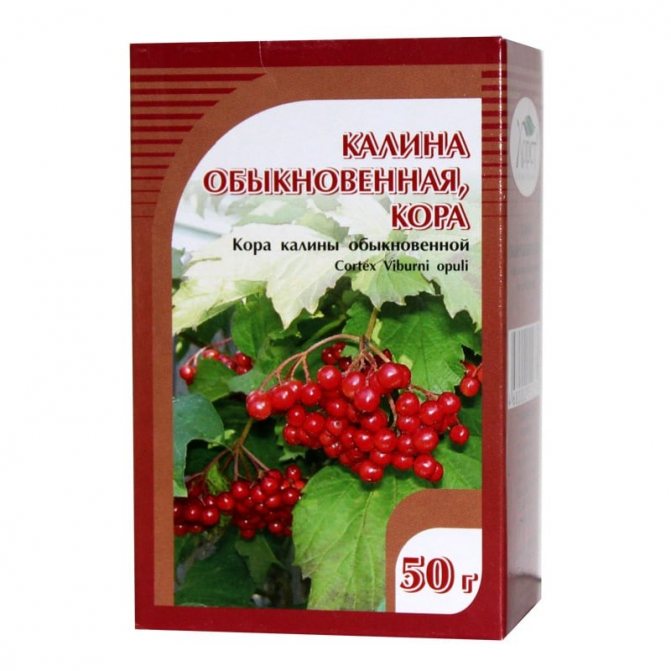

Inexpensive ready-made raw materials can be purchased in a pharmacy in good quality
Regional features
The climatic conditions of different parts of Russia differ significantly from each other. For the successful cultivation of viburnum, it is necessary to plant zoned plants.
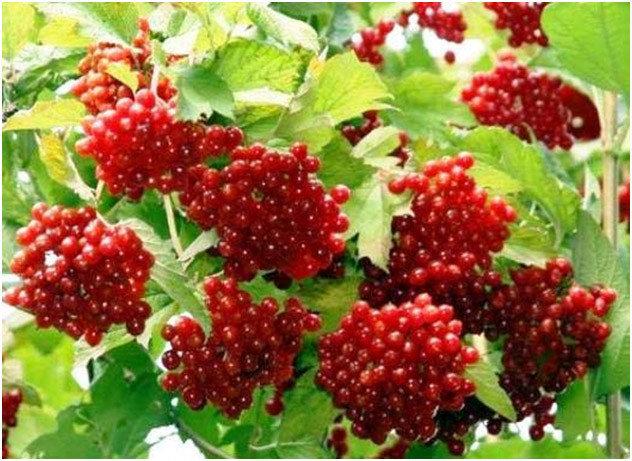

Middle lane
In the conditions of central Russia, the following varieties are widespread:
- Zholobovskaya;
- Souzga;
- Ulgen;
- Taiga rubies.
They do equally well in high temperatures in summer and low in winter.
Krasnodar region
Good yields of berries when grown in the Krasnodar Territory are obtained from the following varieties:
- Red bunch;
- Garnet bracelet;
- Elixira;
- Aurora.
They are undemanding to moisture and tolerate drought well.
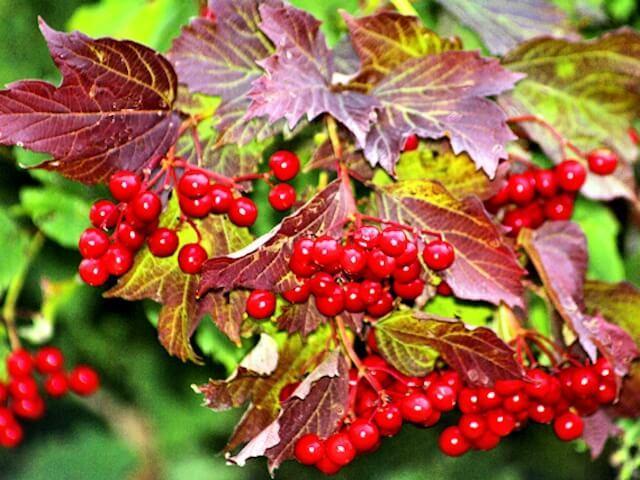

Crimea
The following varieties of viburnum feel great here:
- Avabuki;
- Berkwood;
- Gordovina;
- Cinnamon-leaved.
In the south of Crimea, viburnum blooms in mid-December. Mass bloom is observed in May.
Siberia and the Urals
For cold winters of Siberia and the Urals, winter-hardy varieties are used when planting. Here are common:
- Shukshinskaya;
- Sunset;
- Zarnitsa;
- Maria;
- Ryabinushka.
They are able to withstand cold winters and return frosts.
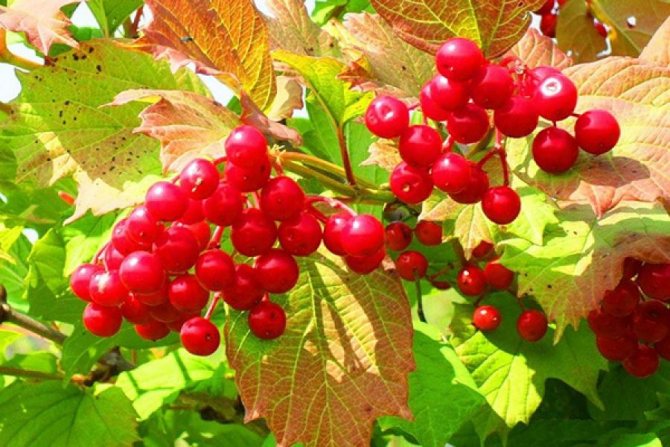

Breeding viburnum
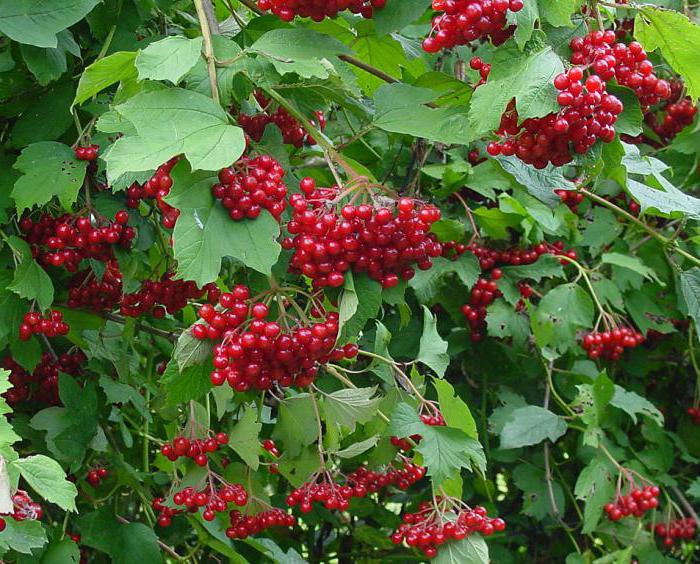

We already know what a viburnum, a shrub or a tree is, and we also have an idea of the peculiarities of planting and caring for this wonderful plant. But how to propagate this shrub? There are several ways to do this, but we will consider the most common one. To implement it, you need to tilt the lower branch of the bush, bend it and dig in. If you do this in the spring, then by the fall the root system will have formed, and the branch can be separated from the main bush and transplanted to a new place.
Benefit
The fruits contain vitamins K, A, E, C, tannins, organic acids, essential oils, tannins, polyphenols, potassium, iron, zinc, pectins. The berries contain plant substances that are very similar in composition to the female hormone estrogen. Kalina tones up blood vessels, relieves pain, normalizes the work of the heart muscle, promotes blood renewal, reduces the risk of anemia and atherosclerosis, and reduces pain in the heart. The fruits are used to open blood vessels and cleanse cholesterol plaques. The fruits are useful for people with digestive problems, gastritis and colitis.
Viburnum seeds are taken orally when recovering from serious illnesses, they reduce pain with migraines, increase efficiency, raise mood and reduce fatigue. Decoctions from the bark stop bleeding, are used in the presence of long non-healing wounds and surgical sutures.
Not only viburnum fruits are useful, but also flowers, young shoots, leaves with bark. Regular consumption of fruits helps to cope with depression, stress, insomnia, get rid of nervous overstrain. The fruits strengthen the immune system well.
Properties of viburnum berries:
- choleretic
- astringent
- antimicrobial
- antispasmodic
- diaphoretic
- expectorant
- anti-inflammatory
- fortifying
- diuretic
- sedative
- pain reliever



